Ebola Response: Models of Change
VerifiedAdded on 2020/02/05
|22
|8259
|47
AI Summary
This assignment explores how two widely recognized change management models, Kotter's 8-Step Process and Kurt Lewin's 3-Phase Model, can be applied to understand and analyze the response to the Ebola outbreak in West Africa. The paper discusses the challenges faced during the crisis, outlines the key steps involved in each model, and analyzes their effectiveness in managing the complex situation.
Contribute Materials
Your contribution can guide someone’s learning journey. Share your
documents today.
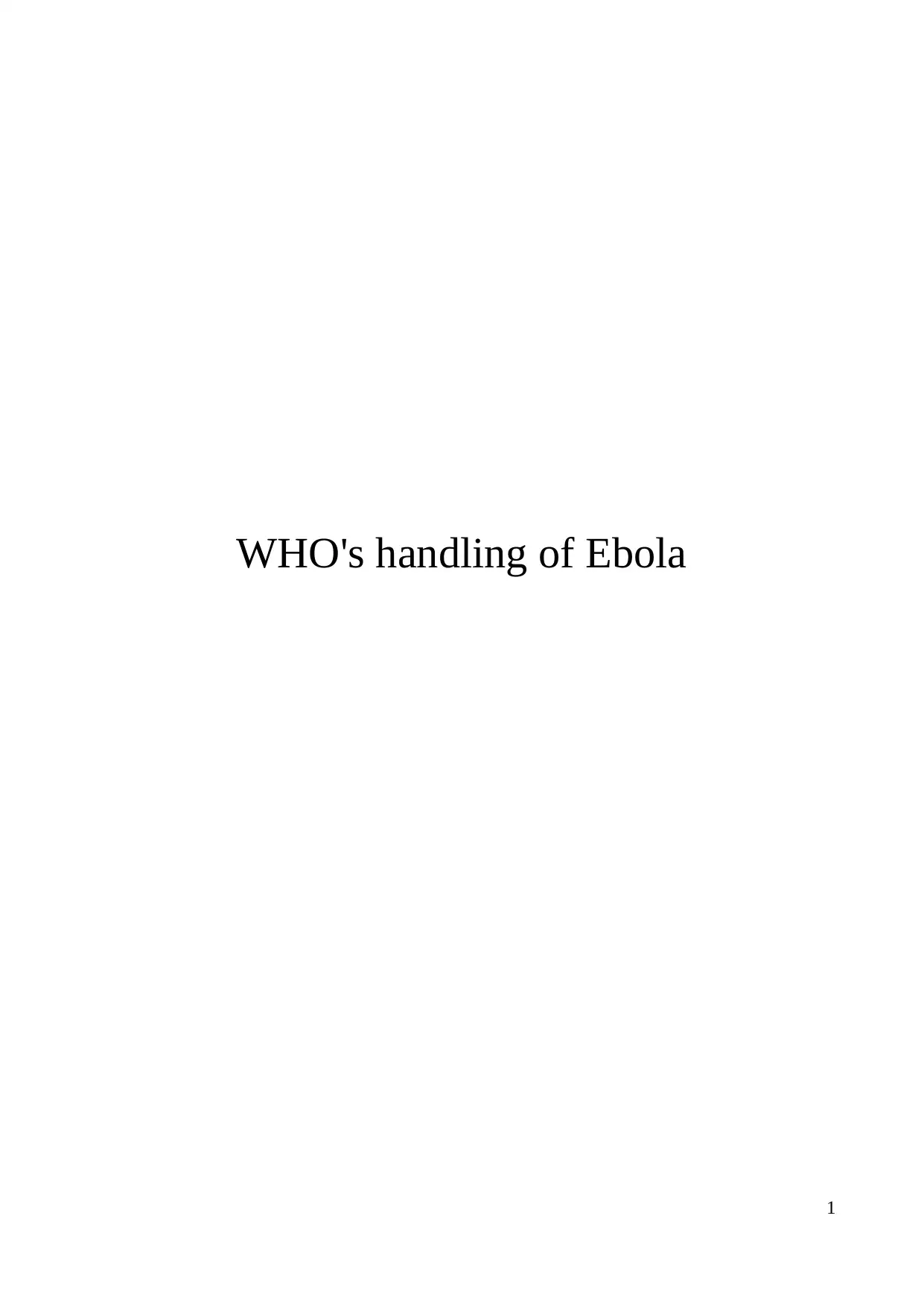
WHO's handling of Ebola
1
1
Secure Best Marks with AI Grader
Need help grading? Try our AI Grader for instant feedback on your assignments.
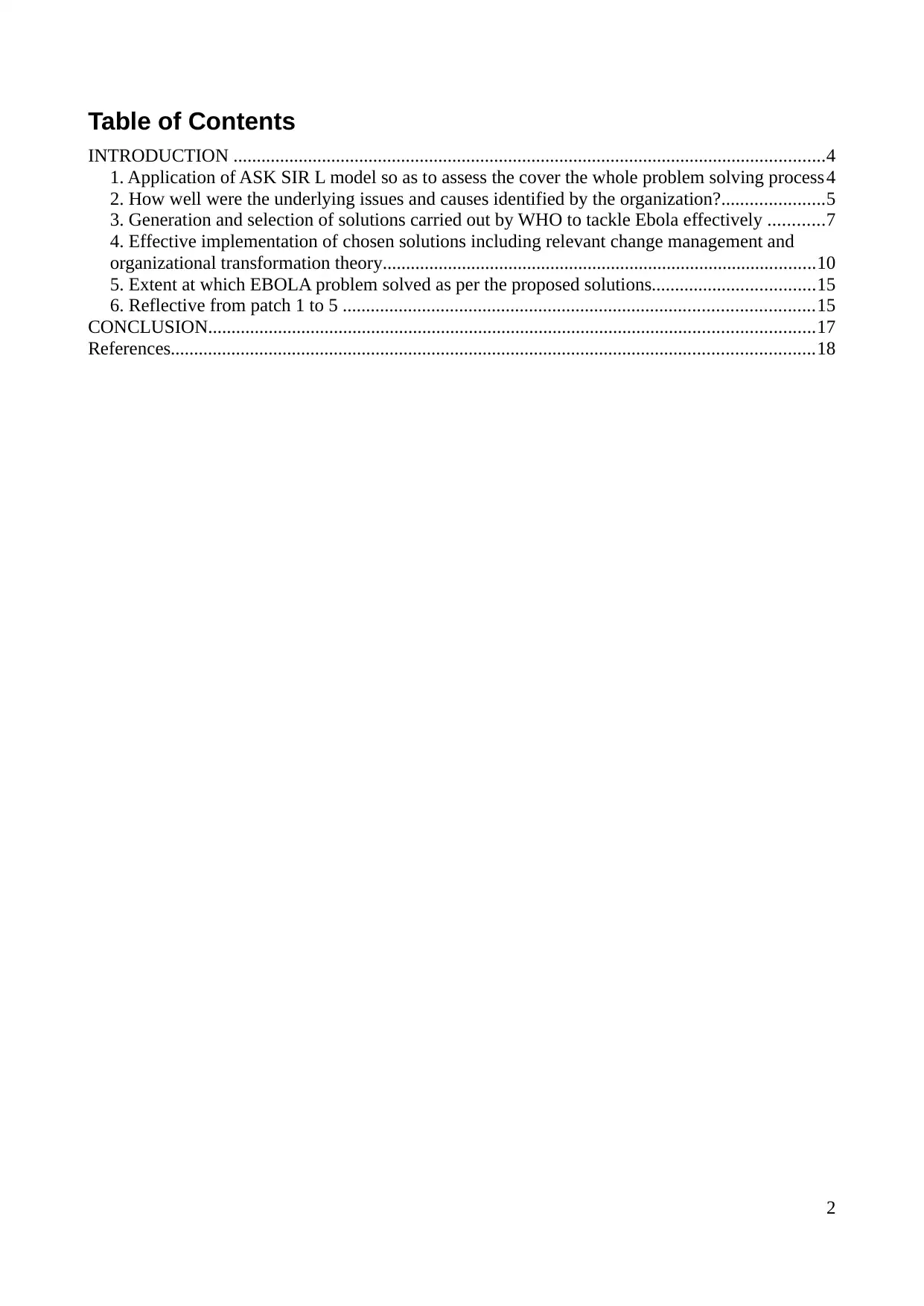
Table of Contents
INTRODUCTION ...............................................................................................................................4
1. Application of ASK SIR L model so as to assess the cover the whole problem solving process4
2. How well were the underlying issues and causes identified by the organization?......................5
3. Generation and selection of solutions carried out by WHO to tackle Ebola effectively ............7
4. Effective implementation of chosen solutions including relevant change management and
organizational transformation theory.............................................................................................10
5. Extent at which EBOLA problem solved as per the proposed solutions...................................15
6. Reflective from patch 1 to 5 .....................................................................................................15
CONCLUSION..................................................................................................................................17
References..........................................................................................................................................18
2
INTRODUCTION ...............................................................................................................................4
1. Application of ASK SIR L model so as to assess the cover the whole problem solving process4
2. How well were the underlying issues and causes identified by the organization?......................5
3. Generation and selection of solutions carried out by WHO to tackle Ebola effectively ............7
4. Effective implementation of chosen solutions including relevant change management and
organizational transformation theory.............................................................................................10
5. Extent at which EBOLA problem solved as per the proposed solutions...................................15
6. Reflective from patch 1 to 5 .....................................................................................................15
CONCLUSION..................................................................................................................................17
References..........................................................................................................................................18
2
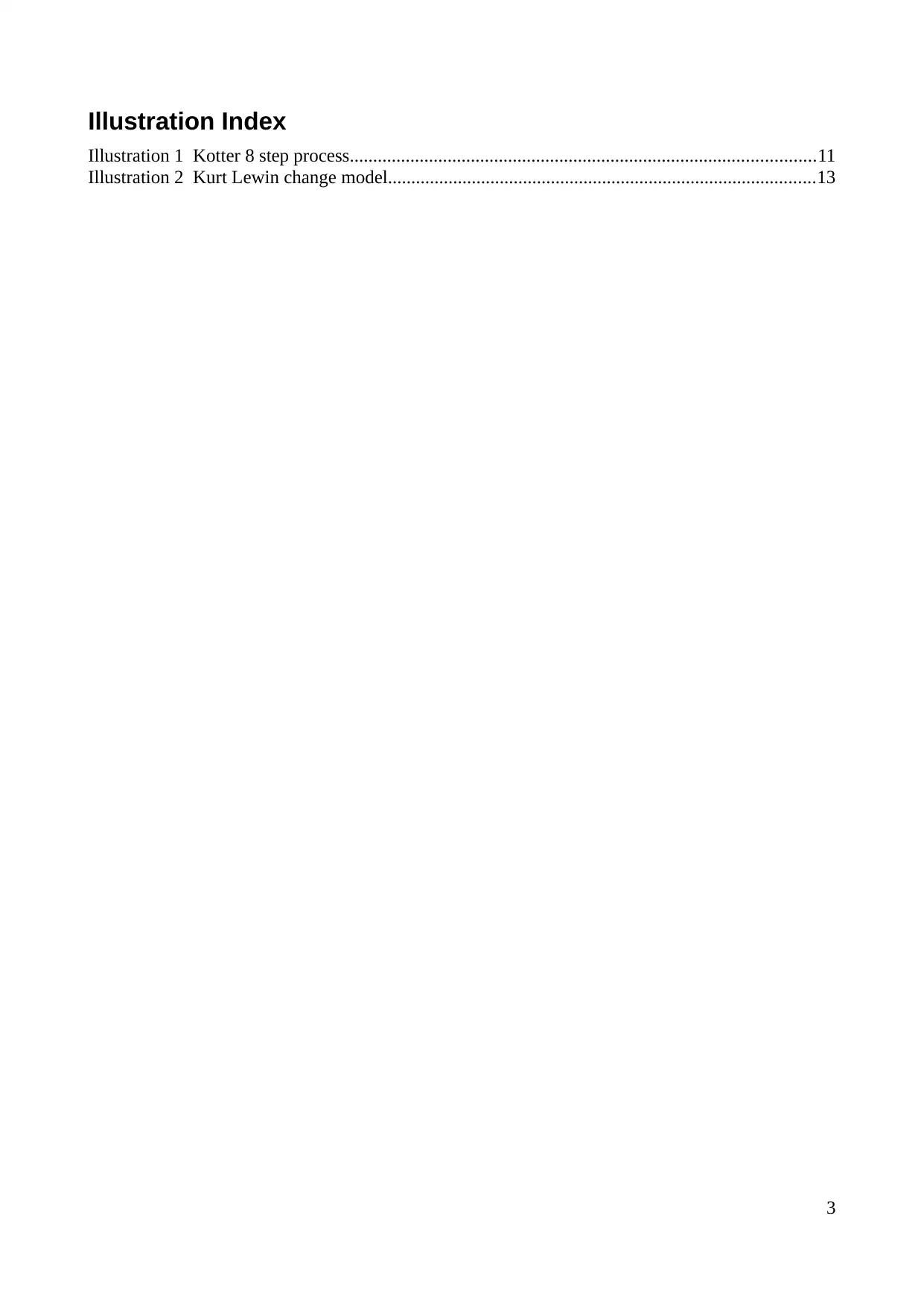
Illustration Index
Illustration 1 Kotter 8 step process....................................................................................................11
Illustration 2 Kurt Lewin change model............................................................................................13
3
Illustration 1 Kotter 8 step process....................................................................................................11
Illustration 2 Kurt Lewin change model............................................................................................13
3
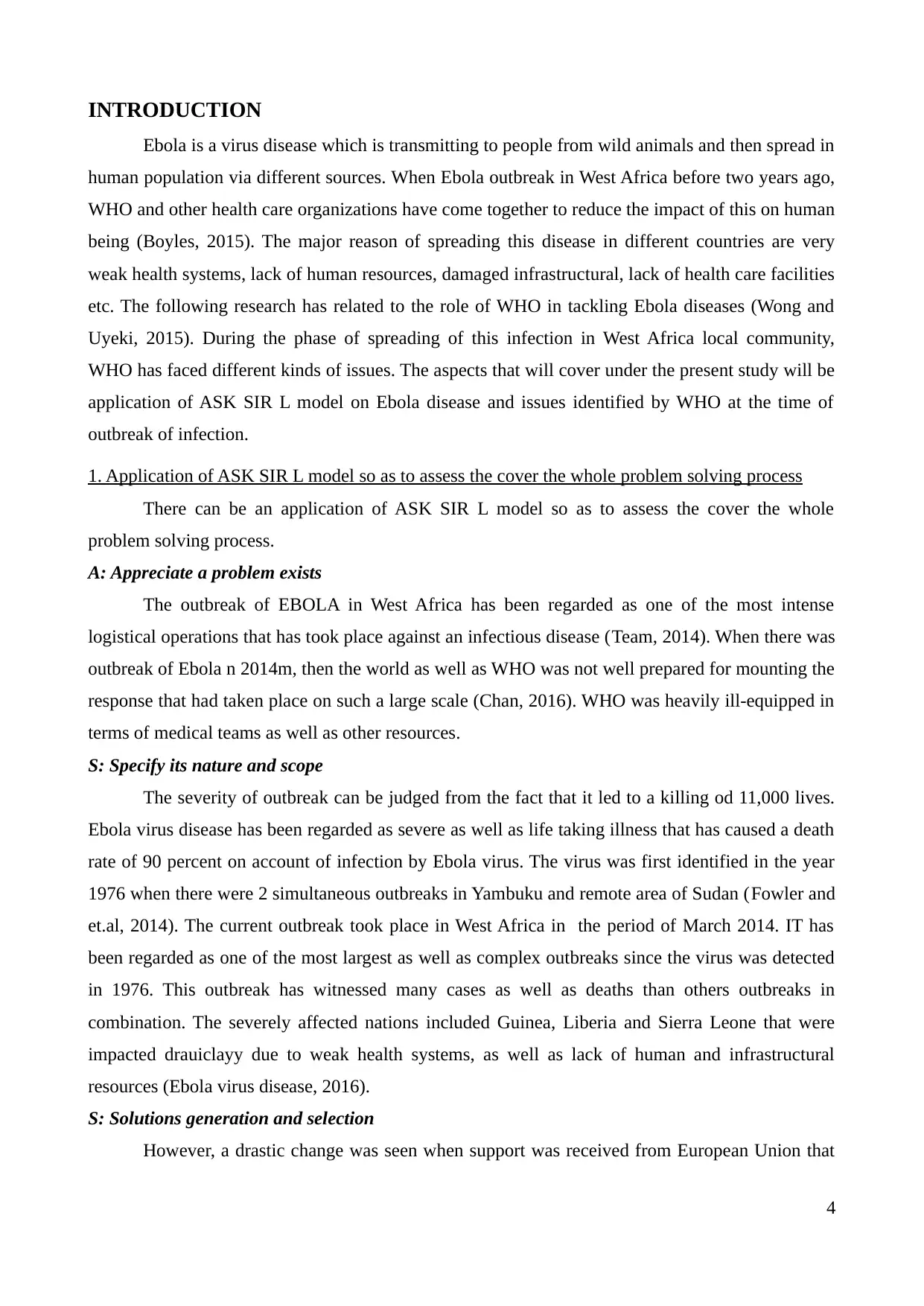
INTRODUCTION
Ebola is a virus disease which is transmitting to people from wild animals and then spread in
human population via different sources. When Ebola outbreak in West Africa before two years ago,
WHO and other health care organizations have come together to reduce the impact of this on human
being (Boyles, 2015). The major reason of spreading this disease in different countries are very
weak health systems, lack of human resources, damaged infrastructural, lack of health care facilities
etc. The following research has related to the role of WHO in tackling Ebola diseases (Wong and
Uyeki, 2015). During the phase of spreading of this infection in West Africa local community,
WHO has faced different kinds of issues. The aspects that will cover under the present study will be
application of ASK SIR L model on Ebola disease and issues identified by WHO at the time of
outbreak of infection.
1. Application of ASK SIR L model so as to assess the cover the whole problem solving process
There can be an application of ASK SIR L model so as to assess the cover the whole
problem solving process.
A: Appreciate a problem exists
The outbreak of EBOLA in West Africa has been regarded as one of the most intense
logistical operations that has took place against an infectious disease (Team, 2014). When there was
outbreak of Ebola n 2014m, then the world as well as WHO was not well prepared for mounting the
response that had taken place on such a large scale (Chan, 2016). WHO was heavily ill-equipped in
terms of medical teams as well as other resources.
S: Specify its nature and scope
The severity of outbreak can be judged from the fact that it led to a killing od 11,000 lives.
Ebola virus disease has been regarded as severe as well as life taking illness that has caused a death
rate of 90 percent on account of infection by Ebola virus. The virus was first identified in the year
1976 when there were 2 simultaneous outbreaks in Yambuku and remote area of Sudan (Fowler and
et.al, 2014). The current outbreak took place in West Africa in the period of March 2014. IT has
been regarded as one of the most largest as well as complex outbreaks since the virus was detected
in 1976. This outbreak has witnessed many cases as well as deaths than others outbreaks in
combination. The severely affected nations included Guinea, Liberia and Sierra Leone that were
impacted drauiclayy due to weak health systems, as well as lack of human and infrastructural
resources (Ebola virus disease, 2016).
S: Solutions generation and selection
However, a drastic change was seen when support was received from European Union that
4
Ebola is a virus disease which is transmitting to people from wild animals and then spread in
human population via different sources. When Ebola outbreak in West Africa before two years ago,
WHO and other health care organizations have come together to reduce the impact of this on human
being (Boyles, 2015). The major reason of spreading this disease in different countries are very
weak health systems, lack of human resources, damaged infrastructural, lack of health care facilities
etc. The following research has related to the role of WHO in tackling Ebola diseases (Wong and
Uyeki, 2015). During the phase of spreading of this infection in West Africa local community,
WHO has faced different kinds of issues. The aspects that will cover under the present study will be
application of ASK SIR L model on Ebola disease and issues identified by WHO at the time of
outbreak of infection.
1. Application of ASK SIR L model so as to assess the cover the whole problem solving process
There can be an application of ASK SIR L model so as to assess the cover the whole
problem solving process.
A: Appreciate a problem exists
The outbreak of EBOLA in West Africa has been regarded as one of the most intense
logistical operations that has took place against an infectious disease (Team, 2014). When there was
outbreak of Ebola n 2014m, then the world as well as WHO was not well prepared for mounting the
response that had taken place on such a large scale (Chan, 2016). WHO was heavily ill-equipped in
terms of medical teams as well as other resources.
S: Specify its nature and scope
The severity of outbreak can be judged from the fact that it led to a killing od 11,000 lives.
Ebola virus disease has been regarded as severe as well as life taking illness that has caused a death
rate of 90 percent on account of infection by Ebola virus. The virus was first identified in the year
1976 when there were 2 simultaneous outbreaks in Yambuku and remote area of Sudan (Fowler and
et.al, 2014). The current outbreak took place in West Africa in the period of March 2014. IT has
been regarded as one of the most largest as well as complex outbreaks since the virus was detected
in 1976. This outbreak has witnessed many cases as well as deaths than others outbreaks in
combination. The severely affected nations included Guinea, Liberia and Sierra Leone that were
impacted drauiclayy due to weak health systems, as well as lack of human and infrastructural
resources (Ebola virus disease, 2016).
S: Solutions generation and selection
However, a drastic change was seen when support was received from European Union that
4
Secure Best Marks with AI Grader
Need help grading? Try our AI Grader for instant feedback on your assignments.
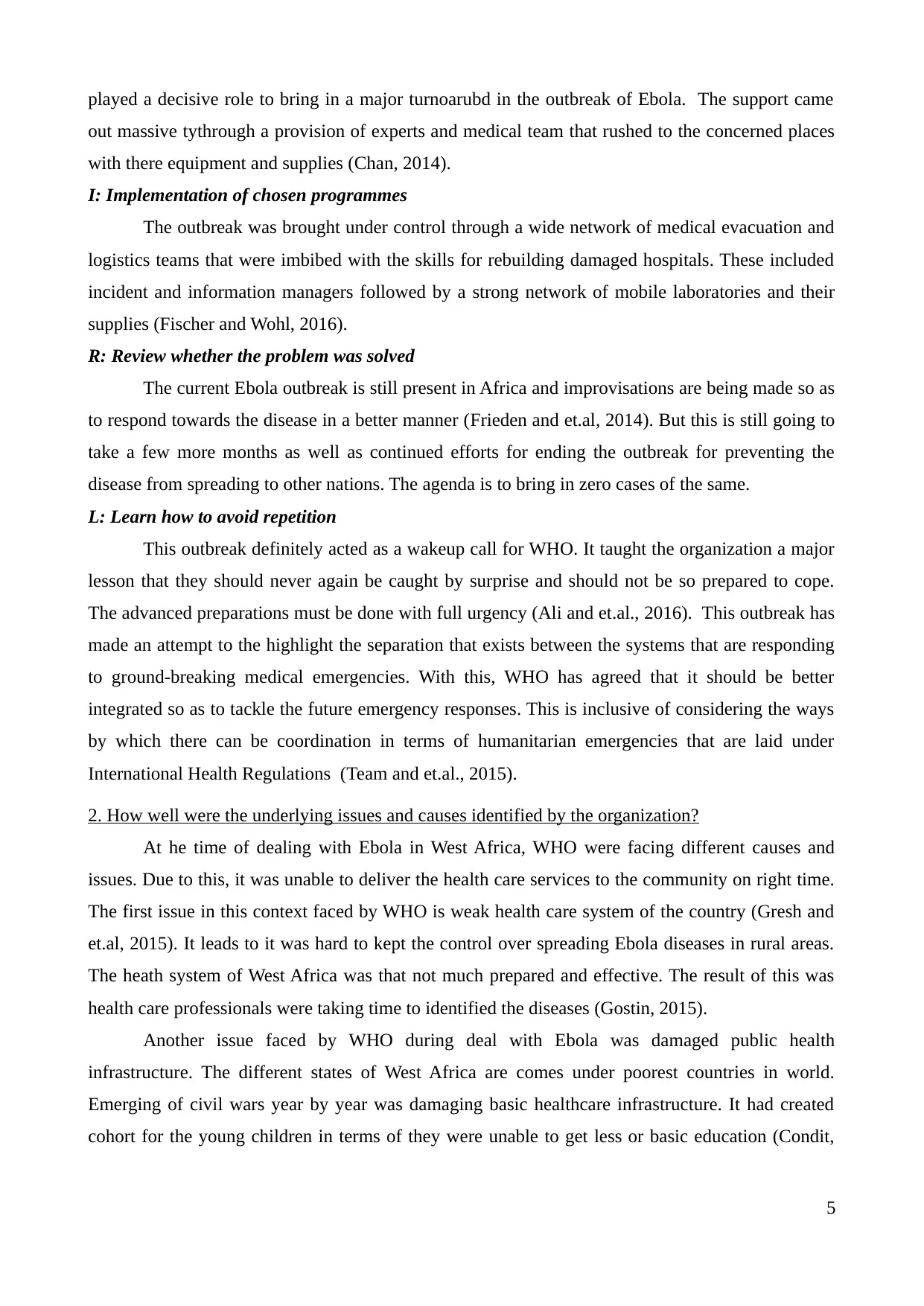
played a decisive role to bring in a major turnoarubd in the outbreak of Ebola. The support came
out massive tythrough a provision of experts and medical team that rushed to the concerned places
with there equipment and supplies (Chan, 2014).
I: Implementation of chosen programmes
The outbreak was brought under control through a wide network of medical evacuation and
logistics teams that were imbibed with the skills for rebuilding damaged hospitals. These included
incident and information managers followed by a strong network of mobile laboratories and their
supplies (Fischer and Wohl, 2016).
R: Review whether the problem was solved
The current Ebola outbreak is still present in Africa and improvisations are being made so as
to respond towards the disease in a better manner (Frieden and et.al, 2014). But this is still going to
take a few more months as well as continued efforts for ending the outbreak for preventing the
disease from spreading to other nations. The agenda is to bring in zero cases of the same.
L: Learn how to avoid repetition
This outbreak definitely acted as a wakeup call for WHO. It taught the organization a major
lesson that they should never again be caught by surprise and should not be so prepared to cope.
The advanced preparations must be done with full urgency (Ali and et.al., 2016). This outbreak has
made an attempt to the highlight the separation that exists between the systems that are responding
to ground-breaking medical emergencies. With this, WHO has agreed that it should be better
integrated so as to tackle the future emergency responses. This is inclusive of considering the ways
by which there can be coordination in terms of humanitarian emergencies that are laid under
International Health Regulations (Team and et.al., 2015).
2. How well were the underlying issues and causes identified by the organization?
At he time of dealing with Ebola in West Africa, WHO were facing different causes and
issues. Due to this, it was unable to deliver the health care services to the community on right time.
The first issue in this context faced by WHO is weak health care system of the country (Gresh and
et.al, 2015). It leads to it was hard to kept the control over spreading Ebola diseases in rural areas.
The heath system of West Africa was that not much prepared and effective. The result of this was
health care professionals were taking time to identified the diseases (Gostin, 2015).
Another issue faced by WHO during deal with Ebola was damaged public health
infrastructure. The different states of West Africa are comes under poorest countries in world.
Emerging of civil wars year by year was damaging basic healthcare infrastructure. It had created
cohort for the young children in terms of they were unable to get less or basic education (Condit,
5
out massive tythrough a provision of experts and medical team that rushed to the concerned places
with there equipment and supplies (Chan, 2014).
I: Implementation of chosen programmes
The outbreak was brought under control through a wide network of medical evacuation and
logistics teams that were imbibed with the skills for rebuilding damaged hospitals. These included
incident and information managers followed by a strong network of mobile laboratories and their
supplies (Fischer and Wohl, 2016).
R: Review whether the problem was solved
The current Ebola outbreak is still present in Africa and improvisations are being made so as
to respond towards the disease in a better manner (Frieden and et.al, 2014). But this is still going to
take a few more months as well as continued efforts for ending the outbreak for preventing the
disease from spreading to other nations. The agenda is to bring in zero cases of the same.
L: Learn how to avoid repetition
This outbreak definitely acted as a wakeup call for WHO. It taught the organization a major
lesson that they should never again be caught by surprise and should not be so prepared to cope.
The advanced preparations must be done with full urgency (Ali and et.al., 2016). This outbreak has
made an attempt to the highlight the separation that exists between the systems that are responding
to ground-breaking medical emergencies. With this, WHO has agreed that it should be better
integrated so as to tackle the future emergency responses. This is inclusive of considering the ways
by which there can be coordination in terms of humanitarian emergencies that are laid under
International Health Regulations (Team and et.al., 2015).
2. How well were the underlying issues and causes identified by the organization?
At he time of dealing with Ebola in West Africa, WHO were facing different causes and
issues. Due to this, it was unable to deliver the health care services to the community on right time.
The first issue in this context faced by WHO is weak health care system of the country (Gresh and
et.al, 2015). It leads to it was hard to kept the control over spreading Ebola diseases in rural areas.
The heath system of West Africa was that not much prepared and effective. The result of this was
health care professionals were taking time to identified the diseases (Gostin, 2015).
Another issue faced by WHO during deal with Ebola was damaged public health
infrastructure. The different states of West Africa are comes under poorest countries in world.
Emerging of civil wars year by year was damaging basic healthcare infrastructure. It had created
cohort for the young children in terms of they were unable to get less or basic education (Condit,
5
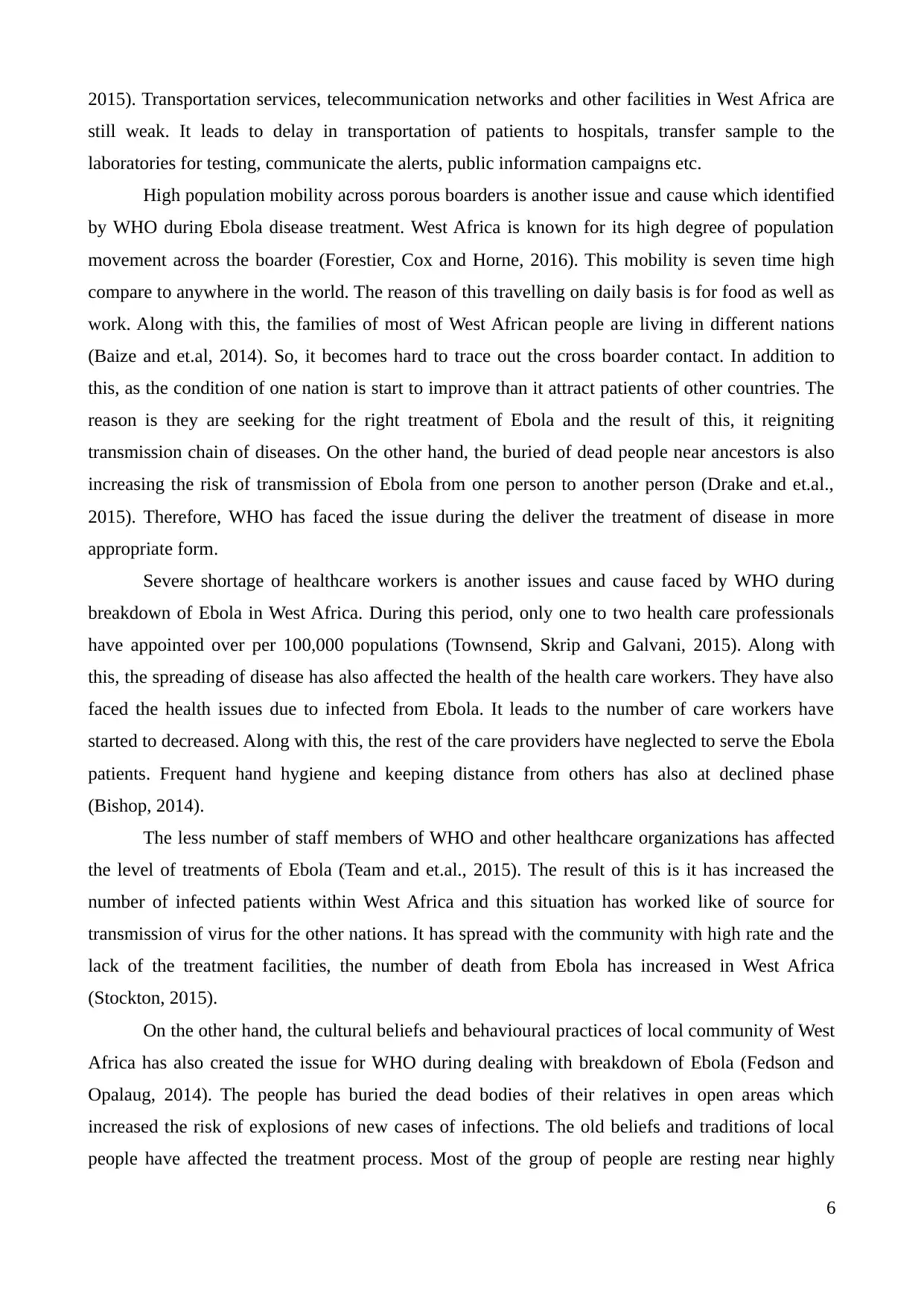
2015). Transportation services, telecommunication networks and other facilities in West Africa are
still weak. It leads to delay in transportation of patients to hospitals, transfer sample to the
laboratories for testing, communicate the alerts, public information campaigns etc.
High population mobility across porous boarders is another issue and cause which identified
by WHO during Ebola disease treatment. West Africa is known for its high degree of population
movement across the boarder (Forestier, Cox and Horne, 2016). This mobility is seven time high
compare to anywhere in the world. The reason of this travelling on daily basis is for food as well as
work. Along with this, the families of most of West African people are living in different nations
(Baize and et.al, 2014). So, it becomes hard to trace out the cross boarder contact. In addition to
this, as the condition of one nation is start to improve than it attract patients of other countries. The
reason is they are seeking for the right treatment of Ebola and the result of this, it reigniting
transmission chain of diseases. On the other hand, the buried of dead people near ancestors is also
increasing the risk of transmission of Ebola from one person to another person (Drake and et.al.,
2015). Therefore, WHO has faced the issue during the deliver the treatment of disease in more
appropriate form.
Severe shortage of healthcare workers is another issues and cause faced by WHO during
breakdown of Ebola in West Africa. During this period, only one to two health care professionals
have appointed over per 100,000 populations (Townsend, Skrip and Galvani, 2015). Along with
this, the spreading of disease has also affected the health of the health care workers. They have also
faced the health issues due to infected from Ebola. It leads to the number of care workers have
started to decreased. Along with this, the rest of the care providers have neglected to serve the Ebola
patients. Frequent hand hygiene and keeping distance from others has also at declined phase
(Bishop, 2014).
The less number of staff members of WHO and other healthcare organizations has affected
the level of treatments of Ebola (Team and et.al., 2015). The result of this is it has increased the
number of infected patients within West Africa and this situation has worked like of source for
transmission of virus for the other nations. It has spread with the community with high rate and the
lack of the treatment facilities, the number of death from Ebola has increased in West Africa
(Stockton, 2015).
On the other hand, the cultural beliefs and behavioural practices of local community of West
Africa has also created the issue for WHO during dealing with breakdown of Ebola (Fedson and
Opalaug, 2014). The people has buried the dead bodies of their relatives in open areas which
increased the risk of explosions of new cases of infections. The old beliefs and traditions of local
people have affected the treatment process. Most of the group of people are resting near highly
6
still weak. It leads to delay in transportation of patients to hospitals, transfer sample to the
laboratories for testing, communicate the alerts, public information campaigns etc.
High population mobility across porous boarders is another issue and cause which identified
by WHO during Ebola disease treatment. West Africa is known for its high degree of population
movement across the boarder (Forestier, Cox and Horne, 2016). This mobility is seven time high
compare to anywhere in the world. The reason of this travelling on daily basis is for food as well as
work. Along with this, the families of most of West African people are living in different nations
(Baize and et.al, 2014). So, it becomes hard to trace out the cross boarder contact. In addition to
this, as the condition of one nation is start to improve than it attract patients of other countries. The
reason is they are seeking for the right treatment of Ebola and the result of this, it reigniting
transmission chain of diseases. On the other hand, the buried of dead people near ancestors is also
increasing the risk of transmission of Ebola from one person to another person (Drake and et.al.,
2015). Therefore, WHO has faced the issue during the deliver the treatment of disease in more
appropriate form.
Severe shortage of healthcare workers is another issues and cause faced by WHO during
breakdown of Ebola in West Africa. During this period, only one to two health care professionals
have appointed over per 100,000 populations (Townsend, Skrip and Galvani, 2015). Along with
this, the spreading of disease has also affected the health of the health care workers. They have also
faced the health issues due to infected from Ebola. It leads to the number of care workers have
started to decreased. Along with this, the rest of the care providers have neglected to serve the Ebola
patients. Frequent hand hygiene and keeping distance from others has also at declined phase
(Bishop, 2014).
The less number of staff members of WHO and other healthcare organizations has affected
the level of treatments of Ebola (Team and et.al., 2015). The result of this is it has increased the
number of infected patients within West Africa and this situation has worked like of source for
transmission of virus for the other nations. It has spread with the community with high rate and the
lack of the treatment facilities, the number of death from Ebola has increased in West Africa
(Stockton, 2015).
On the other hand, the cultural beliefs and behavioural practices of local community of West
Africa has also created the issue for WHO during dealing with breakdown of Ebola (Fedson and
Opalaug, 2014). The people has buried the dead bodies of their relatives in open areas which
increased the risk of explosions of new cases of infections. The old beliefs and traditions of local
people have affected the treatment process. Most of the group of people are resting near highly
6
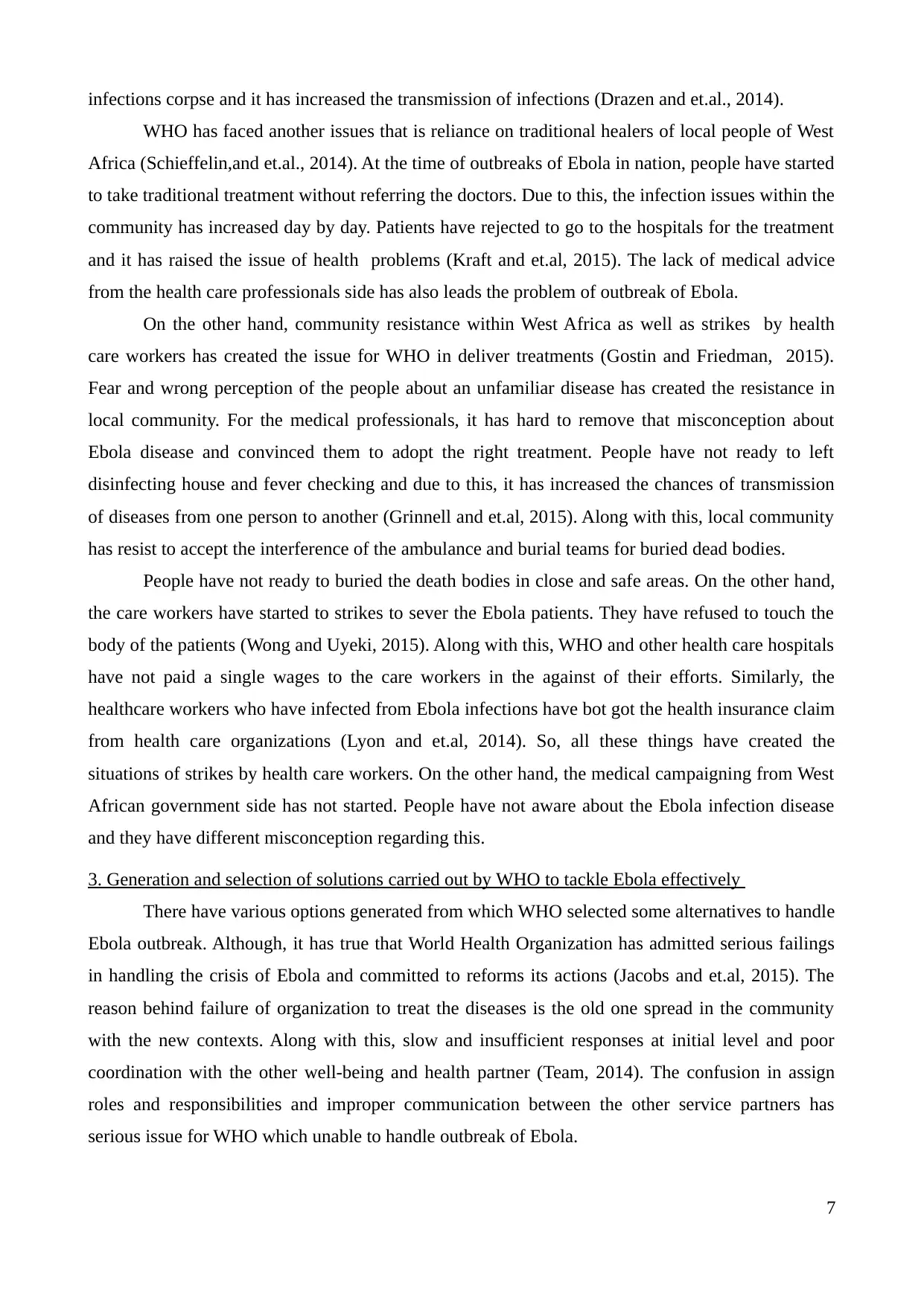
infections corpse and it has increased the transmission of infections (Drazen and et.al., 2014).
WHO has faced another issues that is reliance on traditional healers of local people of West
Africa (Schieffelin,and et.al., 2014). At the time of outbreaks of Ebola in nation, people have started
to take traditional treatment without referring the doctors. Due to this, the infection issues within the
community has increased day by day. Patients have rejected to go to the hospitals for the treatment
and it has raised the issue of health problems (Kraft and et.al, 2015). The lack of medical advice
from the health care professionals side has also leads the problem of outbreak of Ebola.
On the other hand, community resistance within West Africa as well as strikes by health
care workers has created the issue for WHO in deliver treatments (Gostin and Friedman, 2015).
Fear and wrong perception of the people about an unfamiliar disease has created the resistance in
local community. For the medical professionals, it has hard to remove that misconception about
Ebola disease and convinced them to adopt the right treatment. People have not ready to left
disinfecting house and fever checking and due to this, it has increased the chances of transmission
of diseases from one person to another (Grinnell and et.al, 2015). Along with this, local community
has resist to accept the interference of the ambulance and burial teams for buried dead bodies.
People have not ready to buried the death bodies in close and safe areas. On the other hand,
the care workers have started to strikes to sever the Ebola patients. They have refused to touch the
body of the patients (Wong and Uyeki, 2015). Along with this, WHO and other health care hospitals
have not paid a single wages to the care workers in the against of their efforts. Similarly, the
healthcare workers who have infected from Ebola infections have bot got the health insurance claim
from health care organizations (Lyon and et.al, 2014). So, all these things have created the
situations of strikes by health care workers. On the other hand, the medical campaigning from West
African government side has not started. People have not aware about the Ebola infection disease
and they have different misconception regarding this.
3. Generation and selection of solutions carried out by WHO to tackle Ebola effectively
There have various options generated from which WHO selected some alternatives to handle
Ebola outbreak. Although, it has true that World Health Organization has admitted serious failings
in handling the crisis of Ebola and committed to reforms its actions (Jacobs and et.al, 2015). The
reason behind failure of organization to treat the diseases is the old one spread in the community
with the new contexts. Along with this, slow and insufficient responses at initial level and poor
coordination with the other well-being and health partner (Team, 2014). The confusion in assign
roles and responsibilities and improper communication between the other service partners has
serious issue for WHO which unable to handle outbreak of Ebola.
7
WHO has faced another issues that is reliance on traditional healers of local people of West
Africa (Schieffelin,and et.al., 2014). At the time of outbreaks of Ebola in nation, people have started
to take traditional treatment without referring the doctors. Due to this, the infection issues within the
community has increased day by day. Patients have rejected to go to the hospitals for the treatment
and it has raised the issue of health problems (Kraft and et.al, 2015). The lack of medical advice
from the health care professionals side has also leads the problem of outbreak of Ebola.
On the other hand, community resistance within West Africa as well as strikes by health
care workers has created the issue for WHO in deliver treatments (Gostin and Friedman, 2015).
Fear and wrong perception of the people about an unfamiliar disease has created the resistance in
local community. For the medical professionals, it has hard to remove that misconception about
Ebola disease and convinced them to adopt the right treatment. People have not ready to left
disinfecting house and fever checking and due to this, it has increased the chances of transmission
of diseases from one person to another (Grinnell and et.al, 2015). Along with this, local community
has resist to accept the interference of the ambulance and burial teams for buried dead bodies.
People have not ready to buried the death bodies in close and safe areas. On the other hand,
the care workers have started to strikes to sever the Ebola patients. They have refused to touch the
body of the patients (Wong and Uyeki, 2015). Along with this, WHO and other health care hospitals
have not paid a single wages to the care workers in the against of their efforts. Similarly, the
healthcare workers who have infected from Ebola infections have bot got the health insurance claim
from health care organizations (Lyon and et.al, 2014). So, all these things have created the
situations of strikes by health care workers. On the other hand, the medical campaigning from West
African government side has not started. People have not aware about the Ebola infection disease
and they have different misconception regarding this.
3. Generation and selection of solutions carried out by WHO to tackle Ebola effectively
There have various options generated from which WHO selected some alternatives to handle
Ebola outbreak. Although, it has true that World Health Organization has admitted serious failings
in handling the crisis of Ebola and committed to reforms its actions (Jacobs and et.al, 2015). The
reason behind failure of organization to treat the diseases is the old one spread in the community
with the new contexts. Along with this, slow and insufficient responses at initial level and poor
coordination with the other well-being and health partner (Team, 2014). The confusion in assign
roles and responsibilities and improper communication between the other service partners has
serious issue for WHO which unable to handle outbreak of Ebola.
7
Paraphrase This Document
Need a fresh take? Get an instant paraphrase of this document with our AI Paraphraser
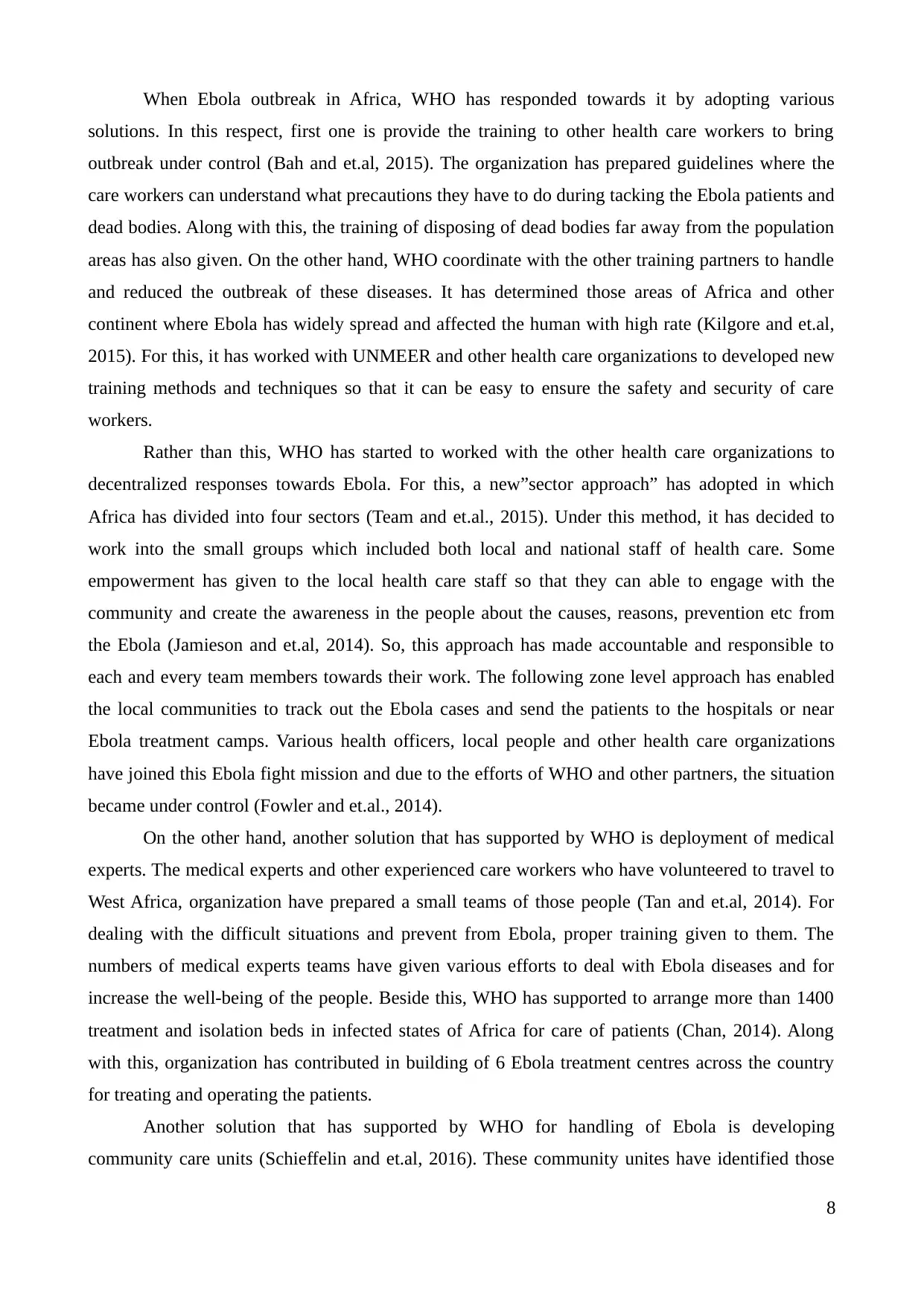
When Ebola outbreak in Africa, WHO has responded towards it by adopting various
solutions. In this respect, first one is provide the training to other health care workers to bring
outbreak under control (Bah and et.al, 2015). The organization has prepared guidelines where the
care workers can understand what precautions they have to do during tacking the Ebola patients and
dead bodies. Along with this, the training of disposing of dead bodies far away from the population
areas has also given. On the other hand, WHO coordinate with the other training partners to handle
and reduced the outbreak of these diseases. It has determined those areas of Africa and other
continent where Ebola has widely spread and affected the human with high rate (Kilgore and et.al,
2015). For this, it has worked with UNMEER and other health care organizations to developed new
training methods and techniques so that it can be easy to ensure the safety and security of care
workers.
Rather than this, WHO has started to worked with the other health care organizations to
decentralized responses towards Ebola. For this, a new”sector approach” has adopted in which
Africa has divided into four sectors (Team and et.al., 2015). Under this method, it has decided to
work into the small groups which included both local and national staff of health care. Some
empowerment has given to the local health care staff so that they can able to engage with the
community and create the awareness in the people about the causes, reasons, prevention etc from
the Ebola (Jamieson and et.al, 2014). So, this approach has made accountable and responsible to
each and every team members towards their work. The following zone level approach has enabled
the local communities to track out the Ebola cases and send the patients to the hospitals or near
Ebola treatment camps. Various health officers, local people and other health care organizations
have joined this Ebola fight mission and due to the efforts of WHO and other partners, the situation
became under control (Fowler and et.al., 2014).
On the other hand, another solution that has supported by WHO is deployment of medical
experts. The medical experts and other experienced care workers who have volunteered to travel to
West Africa, organization have prepared a small teams of those people (Tan and et.al, 2014). For
dealing with the difficult situations and prevent from Ebola, proper training given to them. The
numbers of medical experts teams have given various efforts to deal with Ebola diseases and for
increase the well-being of the people. Beside this, WHO has supported to arrange more than 1400
treatment and isolation beds in infected states of Africa for care of patients (Chan, 2014). Along
with this, organization has contributed in building of 6 Ebola treatment centres across the country
for treating and operating the patients.
Another solution that has supported by WHO for handling of Ebola is developing
community care units (Schieffelin and et.al, 2016). These community unites have identified those
8
solutions. In this respect, first one is provide the training to other health care workers to bring
outbreak under control (Bah and et.al, 2015). The organization has prepared guidelines where the
care workers can understand what precautions they have to do during tacking the Ebola patients and
dead bodies. Along with this, the training of disposing of dead bodies far away from the population
areas has also given. On the other hand, WHO coordinate with the other training partners to handle
and reduced the outbreak of these diseases. It has determined those areas of Africa and other
continent where Ebola has widely spread and affected the human with high rate (Kilgore and et.al,
2015). For this, it has worked with UNMEER and other health care organizations to developed new
training methods and techniques so that it can be easy to ensure the safety and security of care
workers.
Rather than this, WHO has started to worked with the other health care organizations to
decentralized responses towards Ebola. For this, a new”sector approach” has adopted in which
Africa has divided into four sectors (Team and et.al., 2015). Under this method, it has decided to
work into the small groups which included both local and national staff of health care. Some
empowerment has given to the local health care staff so that they can able to engage with the
community and create the awareness in the people about the causes, reasons, prevention etc from
the Ebola (Jamieson and et.al, 2014). So, this approach has made accountable and responsible to
each and every team members towards their work. The following zone level approach has enabled
the local communities to track out the Ebola cases and send the patients to the hospitals or near
Ebola treatment camps. Various health officers, local people and other health care organizations
have joined this Ebola fight mission and due to the efforts of WHO and other partners, the situation
became under control (Fowler and et.al., 2014).
On the other hand, another solution that has supported by WHO is deployment of medical
experts. The medical experts and other experienced care workers who have volunteered to travel to
West Africa, organization have prepared a small teams of those people (Tan and et.al, 2014). For
dealing with the difficult situations and prevent from Ebola, proper training given to them. The
numbers of medical experts teams have given various efforts to deal with Ebola diseases and for
increase the well-being of the people. Beside this, WHO has supported to arrange more than 1400
treatment and isolation beds in infected states of Africa for care of patients (Chan, 2014). Along
with this, organization has contributed in building of 6 Ebola treatment centres across the country
for treating and operating the patients.
Another solution that has supported by WHO for handling of Ebola is developing
community care units (Schieffelin and et.al, 2016). These community unites have identified those
8
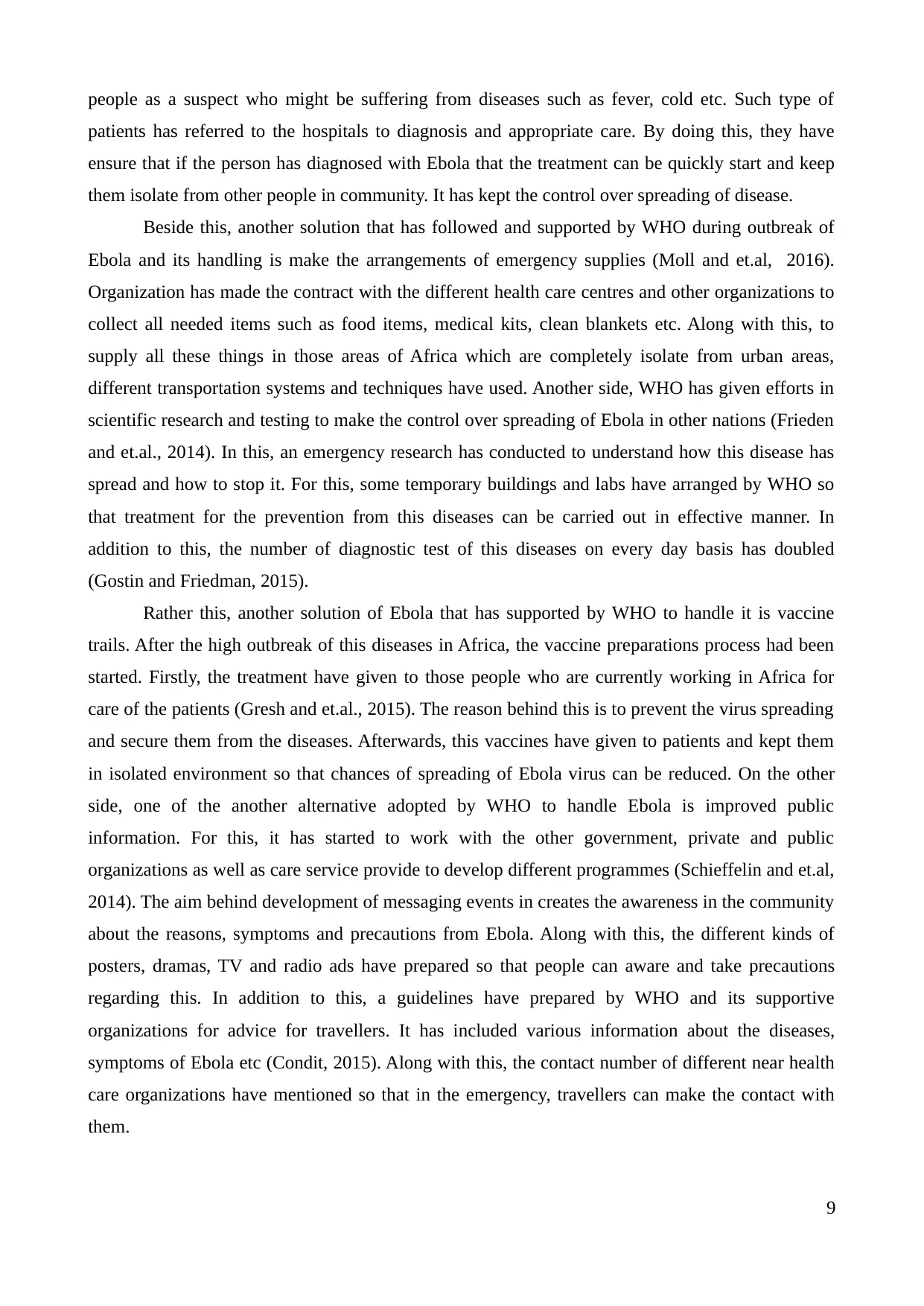
people as a suspect who might be suffering from diseases such as fever, cold etc. Such type of
patients has referred to the hospitals to diagnosis and appropriate care. By doing this, they have
ensure that if the person has diagnosed with Ebola that the treatment can be quickly start and keep
them isolate from other people in community. It has kept the control over spreading of disease.
Beside this, another solution that has followed and supported by WHO during outbreak of
Ebola and its handling is make the arrangements of emergency supplies (Moll and et.al, 2016).
Organization has made the contract with the different health care centres and other organizations to
collect all needed items such as food items, medical kits, clean blankets etc. Along with this, to
supply all these things in those areas of Africa which are completely isolate from urban areas,
different transportation systems and techniques have used. Another side, WHO has given efforts in
scientific research and testing to make the control over spreading of Ebola in other nations (Frieden
and et.al., 2014). In this, an emergency research has conducted to understand how this disease has
spread and how to stop it. For this, some temporary buildings and labs have arranged by WHO so
that treatment for the prevention from this diseases can be carried out in effective manner. In
addition to this, the number of diagnostic test of this diseases on every day basis has doubled
(Gostin and Friedman, 2015).
Rather this, another solution of Ebola that has supported by WHO to handle it is vaccine
trails. After the high outbreak of this diseases in Africa, the vaccine preparations process had been
started. Firstly, the treatment have given to those people who are currently working in Africa for
care of the patients (Gresh and et.al., 2015). The reason behind this is to prevent the virus spreading
and secure them from the diseases. Afterwards, this vaccines have given to patients and kept them
in isolated environment so that chances of spreading of Ebola virus can be reduced. On the other
side, one of the another alternative adopted by WHO to handle Ebola is improved public
information. For this, it has started to work with the other government, private and public
organizations as well as care service provide to develop different programmes (Schieffelin and et.al,
2014). The aim behind development of messaging events in creates the awareness in the community
about the reasons, symptoms and precautions from Ebola. Along with this, the different kinds of
posters, dramas, TV and radio ads have prepared so that people can aware and take precautions
regarding this. In addition to this, a guidelines have prepared by WHO and its supportive
organizations for advice for travellers. It has included various information about the diseases,
symptoms of Ebola etc (Condit, 2015). Along with this, the contact number of different near health
care organizations have mentioned so that in the emergency, travellers can make the contact with
them.
9
patients has referred to the hospitals to diagnosis and appropriate care. By doing this, they have
ensure that if the person has diagnosed with Ebola that the treatment can be quickly start and keep
them isolate from other people in community. It has kept the control over spreading of disease.
Beside this, another solution that has followed and supported by WHO during outbreak of
Ebola and its handling is make the arrangements of emergency supplies (Moll and et.al, 2016).
Organization has made the contract with the different health care centres and other organizations to
collect all needed items such as food items, medical kits, clean blankets etc. Along with this, to
supply all these things in those areas of Africa which are completely isolate from urban areas,
different transportation systems and techniques have used. Another side, WHO has given efforts in
scientific research and testing to make the control over spreading of Ebola in other nations (Frieden
and et.al., 2014). In this, an emergency research has conducted to understand how this disease has
spread and how to stop it. For this, some temporary buildings and labs have arranged by WHO so
that treatment for the prevention from this diseases can be carried out in effective manner. In
addition to this, the number of diagnostic test of this diseases on every day basis has doubled
(Gostin and Friedman, 2015).
Rather this, another solution of Ebola that has supported by WHO to handle it is vaccine
trails. After the high outbreak of this diseases in Africa, the vaccine preparations process had been
started. Firstly, the treatment have given to those people who are currently working in Africa for
care of the patients (Gresh and et.al., 2015). The reason behind this is to prevent the virus spreading
and secure them from the diseases. Afterwards, this vaccines have given to patients and kept them
in isolated environment so that chances of spreading of Ebola virus can be reduced. On the other
side, one of the another alternative adopted by WHO to handle Ebola is improved public
information. For this, it has started to work with the other government, private and public
organizations as well as care service provide to develop different programmes (Schieffelin and et.al,
2014). The aim behind development of messaging events in creates the awareness in the community
about the reasons, symptoms and precautions from Ebola. Along with this, the different kinds of
posters, dramas, TV and radio ads have prepared so that people can aware and take precautions
regarding this. In addition to this, a guidelines have prepared by WHO and its supportive
organizations for advice for travellers. It has included various information about the diseases,
symptoms of Ebola etc (Condit, 2015). Along with this, the contact number of different near health
care organizations have mentioned so that in the emergency, travellers can make the contact with
them.
9
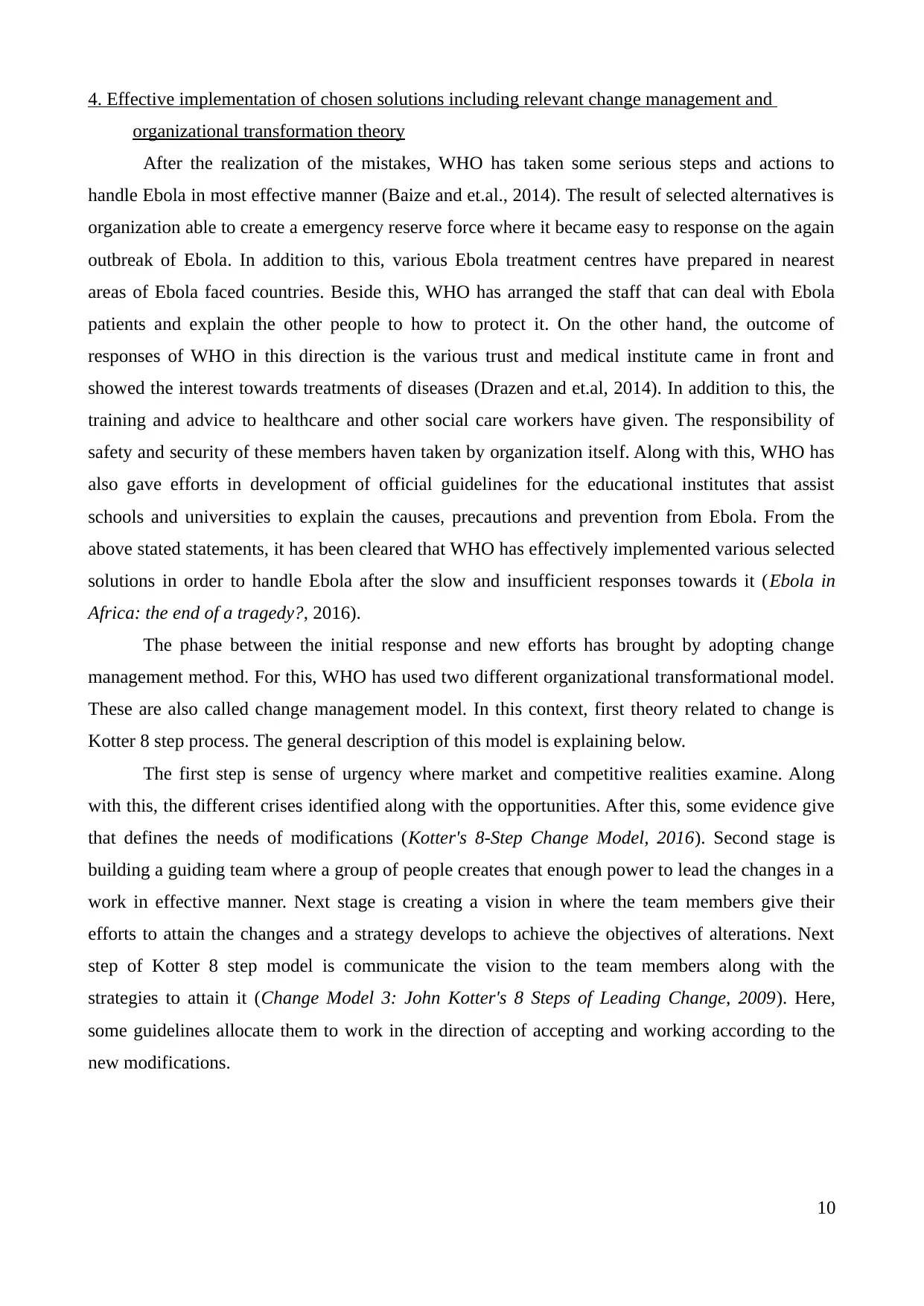
4. Effective implementation of chosen solutions including relevant change management and
organizational transformation theory
After the realization of the mistakes, WHO has taken some serious steps and actions to
handle Ebola in most effective manner (Baize and et.al., 2014). The result of selected alternatives is
organization able to create a emergency reserve force where it became easy to response on the again
outbreak of Ebola. In addition to this, various Ebola treatment centres have prepared in nearest
areas of Ebola faced countries. Beside this, WHO has arranged the staff that can deal with Ebola
patients and explain the other people to how to protect it. On the other hand, the outcome of
responses of WHO in this direction is the various trust and medical institute came in front and
showed the interest towards treatments of diseases (Drazen and et.al, 2014). In addition to this, the
training and advice to healthcare and other social care workers have given. The responsibility of
safety and security of these members haven taken by organization itself. Along with this, WHO has
also gave efforts in development of official guidelines for the educational institutes that assist
schools and universities to explain the causes, precautions and prevention from Ebola. From the
above stated statements, it has been cleared that WHO has effectively implemented various selected
solutions in order to handle Ebola after the slow and insufficient responses towards it (Ebola in
Africa: the end of a tragedy?, 2016).
The phase between the initial response and new efforts has brought by adopting change
management method. For this, WHO has used two different organizational transformational model.
These are also called change management model. In this context, first theory related to change is
Kotter 8 step process. The general description of this model is explaining below.
The first step is sense of urgency where market and competitive realities examine. Along
with this, the different crises identified along with the opportunities. After this, some evidence give
that defines the needs of modifications (Kotter's 8-Step Change Model, 2016). Second stage is
building a guiding team where a group of people creates that enough power to lead the changes in a
work in effective manner. Next stage is creating a vision in where the team members give their
efforts to attain the changes and a strategy develops to achieve the objectives of alterations. Next
step of Kotter 8 step model is communicate the vision to the team members along with the
strategies to attain it (Change Model 3: John Kotter's 8 Steps of Leading Change, 2009). Here,
some guidelines allocate them to work in the direction of accepting and working according to the
new modifications.
10
organizational transformation theory
After the realization of the mistakes, WHO has taken some serious steps and actions to
handle Ebola in most effective manner (Baize and et.al., 2014). The result of selected alternatives is
organization able to create a emergency reserve force where it became easy to response on the again
outbreak of Ebola. In addition to this, various Ebola treatment centres have prepared in nearest
areas of Ebola faced countries. Beside this, WHO has arranged the staff that can deal with Ebola
patients and explain the other people to how to protect it. On the other hand, the outcome of
responses of WHO in this direction is the various trust and medical institute came in front and
showed the interest towards treatments of diseases (Drazen and et.al, 2014). In addition to this, the
training and advice to healthcare and other social care workers have given. The responsibility of
safety and security of these members haven taken by organization itself. Along with this, WHO has
also gave efforts in development of official guidelines for the educational institutes that assist
schools and universities to explain the causes, precautions and prevention from Ebola. From the
above stated statements, it has been cleared that WHO has effectively implemented various selected
solutions in order to handle Ebola after the slow and insufficient responses towards it (Ebola in
Africa: the end of a tragedy?, 2016).
The phase between the initial response and new efforts has brought by adopting change
management method. For this, WHO has used two different organizational transformational model.
These are also called change management model. In this context, first theory related to change is
Kotter 8 step process. The general description of this model is explaining below.
The first step is sense of urgency where market and competitive realities examine. Along
with this, the different crises identified along with the opportunities. After this, some evidence give
that defines the needs of modifications (Kotter's 8-Step Change Model, 2016). Second stage is
building a guiding team where a group of people creates that enough power to lead the changes in a
work in effective manner. Next stage is creating a vision in where the team members give their
efforts to attain the changes and a strategy develops to achieve the objectives of alterations. Next
step of Kotter 8 step model is communicate the vision to the team members along with the
strategies to attain it (Change Model 3: John Kotter's 8 Steps of Leading Change, 2009). Here,
some guidelines allocate them to work in the direction of accepting and working according to the
new modifications.
10
Secure Best Marks with AI Grader
Need help grading? Try our AI Grader for instant feedback on your assignments.
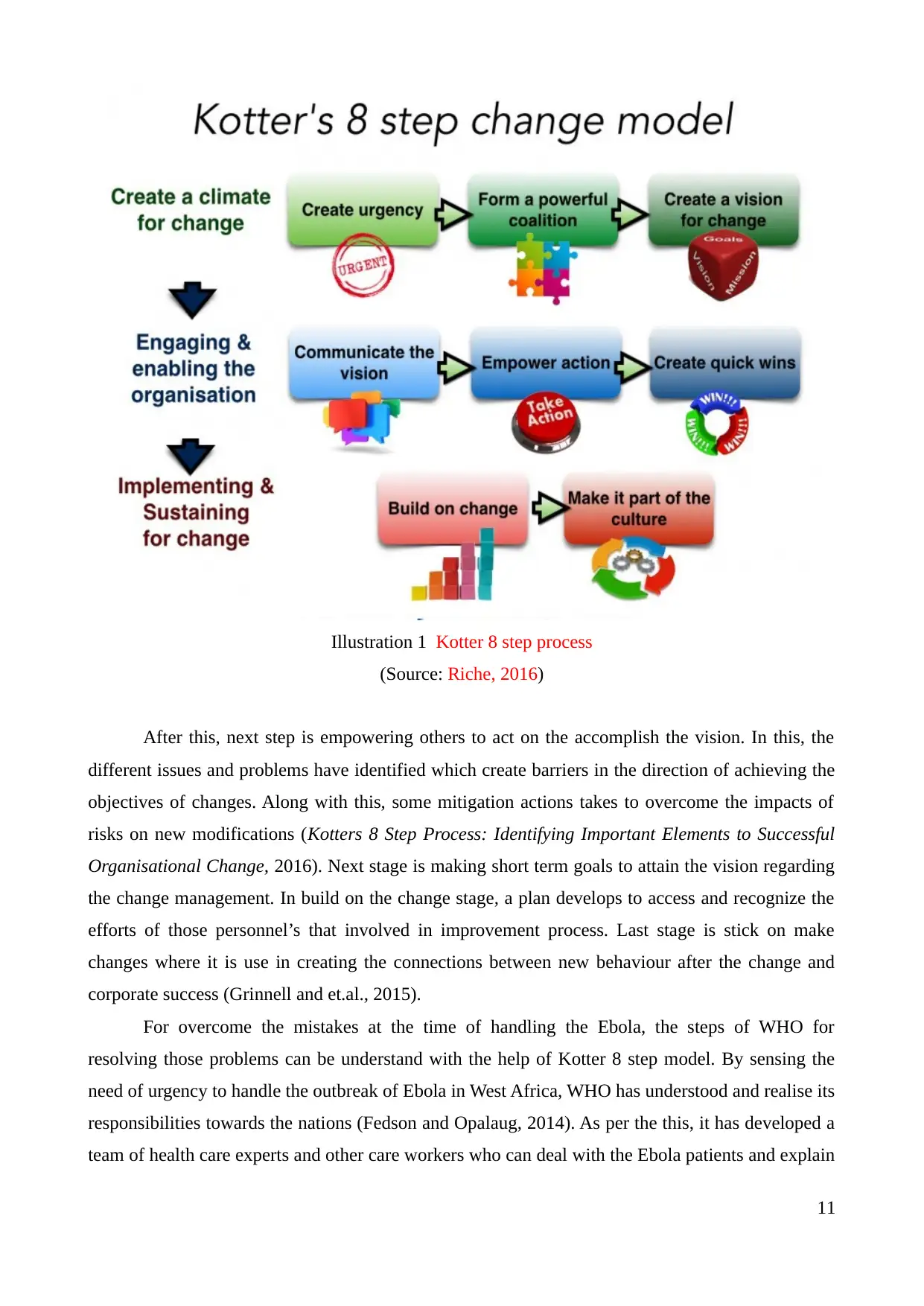
After this, next step is empowering others to act on the accomplish the vision. In this, the
different issues and problems have identified which create barriers in the direction of achieving the
objectives of changes. Along with this, some mitigation actions takes to overcome the impacts of
risks on new modifications (Kotters 8 Step Process: Identifying Important Elements to Successful
Organisational Change, 2016). Next stage is making short term goals to attain the vision regarding
the change management. In build on the change stage, a plan develops to access and recognize the
efforts of those personnel’s that involved in improvement process. Last stage is stick on make
changes where it is use in creating the connections between new behaviour after the change and
corporate success (Grinnell and et.al., 2015).
For overcome the mistakes at the time of handling the Ebola, the steps of WHO for
resolving those problems can be understand with the help of Kotter 8 step model. By sensing the
need of urgency to handle the outbreak of Ebola in West Africa, WHO has understood and realise its
responsibilities towards the nations (Fedson and Opalaug, 2014). As per the this, it has developed a
team of health care experts and other care workers who can deal with the Ebola patients and explain
11
Illustration 1 Kotter 8 step process
(Source: Riche, 2016)
different issues and problems have identified which create barriers in the direction of achieving the
objectives of changes. Along with this, some mitigation actions takes to overcome the impacts of
risks on new modifications (Kotters 8 Step Process: Identifying Important Elements to Successful
Organisational Change, 2016). Next stage is making short term goals to attain the vision regarding
the change management. In build on the change stage, a plan develops to access and recognize the
efforts of those personnel’s that involved in improvement process. Last stage is stick on make
changes where it is use in creating the connections between new behaviour after the change and
corporate success (Grinnell and et.al., 2015).
For overcome the mistakes at the time of handling the Ebola, the steps of WHO for
resolving those problems can be understand with the help of Kotter 8 step model. By sensing the
need of urgency to handle the outbreak of Ebola in West Africa, WHO has understood and realise its
responsibilities towards the nations (Fedson and Opalaug, 2014). As per the this, it has developed a
team of health care experts and other care workers who can deal with the Ebola patients and explain
11
Illustration 1 Kotter 8 step process
(Source: Riche, 2016)
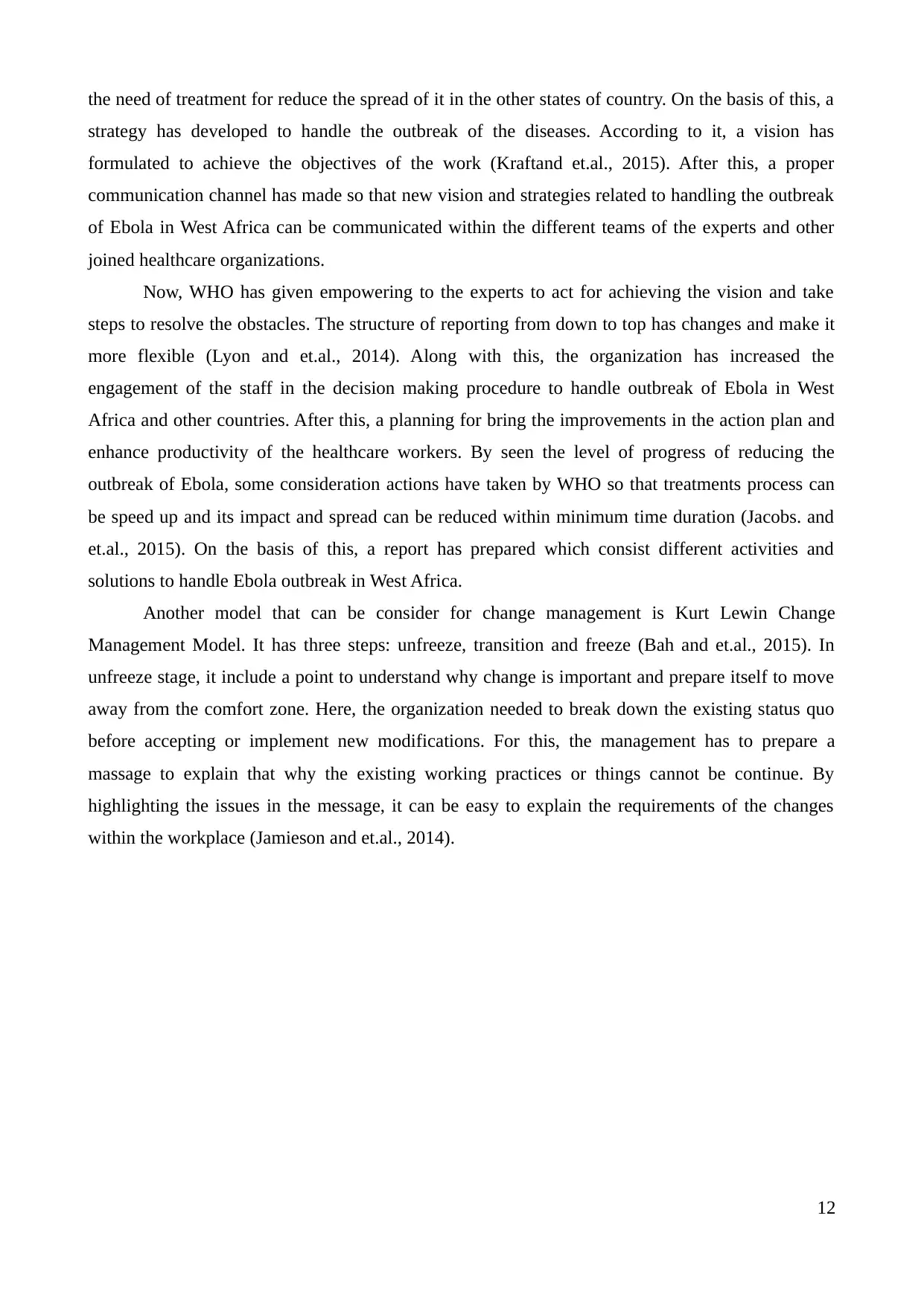
the need of treatment for reduce the spread of it in the other states of country. On the basis of this, a
strategy has developed to handle the outbreak of the diseases. According to it, a vision has
formulated to achieve the objectives of the work (Kraftand et.al., 2015). After this, a proper
communication channel has made so that new vision and strategies related to handling the outbreak
of Ebola in West Africa can be communicated within the different teams of the experts and other
joined healthcare organizations.
Now, WHO has given empowering to the experts to act for achieving the vision and take
steps to resolve the obstacles. The structure of reporting from down to top has changes and make it
more flexible (Lyon and et.al., 2014). Along with this, the organization has increased the
engagement of the staff in the decision making procedure to handle outbreak of Ebola in West
Africa and other countries. After this, a planning for bring the improvements in the action plan and
enhance productivity of the healthcare workers. By seen the level of progress of reducing the
outbreak of Ebola, some consideration actions have taken by WHO so that treatments process can
be speed up and its impact and spread can be reduced within minimum time duration (Jacobs. and
et.al., 2015). On the basis of this, a report has prepared which consist different activities and
solutions to handle Ebola outbreak in West Africa.
Another model that can be consider for change management is Kurt Lewin Change
Management Model. It has three steps: unfreeze, transition and freeze (Bah and et.al., 2015). In
unfreeze stage, it include a point to understand why change is important and prepare itself to move
away from the comfort zone. Here, the organization needed to break down the existing status quo
before accepting or implement new modifications. For this, the management has to prepare a
massage to explain that why the existing working practices or things cannot be continue. By
highlighting the issues in the message, it can be easy to explain the requirements of the changes
within the workplace (Jamieson and et.al., 2014).
12
strategy has developed to handle the outbreak of the diseases. According to it, a vision has
formulated to achieve the objectives of the work (Kraftand et.al., 2015). After this, a proper
communication channel has made so that new vision and strategies related to handling the outbreak
of Ebola in West Africa can be communicated within the different teams of the experts and other
joined healthcare organizations.
Now, WHO has given empowering to the experts to act for achieving the vision and take
steps to resolve the obstacles. The structure of reporting from down to top has changes and make it
more flexible (Lyon and et.al., 2014). Along with this, the organization has increased the
engagement of the staff in the decision making procedure to handle outbreak of Ebola in West
Africa and other countries. After this, a planning for bring the improvements in the action plan and
enhance productivity of the healthcare workers. By seen the level of progress of reducing the
outbreak of Ebola, some consideration actions have taken by WHO so that treatments process can
be speed up and its impact and spread can be reduced within minimum time duration (Jacobs. and
et.al., 2015). On the basis of this, a report has prepared which consist different activities and
solutions to handle Ebola outbreak in West Africa.
Another model that can be consider for change management is Kurt Lewin Change
Management Model. It has three steps: unfreeze, transition and freeze (Bah and et.al., 2015). In
unfreeze stage, it include a point to understand why change is important and prepare itself to move
away from the comfort zone. Here, the organization needed to break down the existing status quo
before accepting or implement new modifications. For this, the management has to prepare a
massage to explain that why the existing working practices or things cannot be continue. By
highlighting the issues in the message, it can be easy to explain the requirements of the changes
within the workplace (Jamieson and et.al., 2014).
12
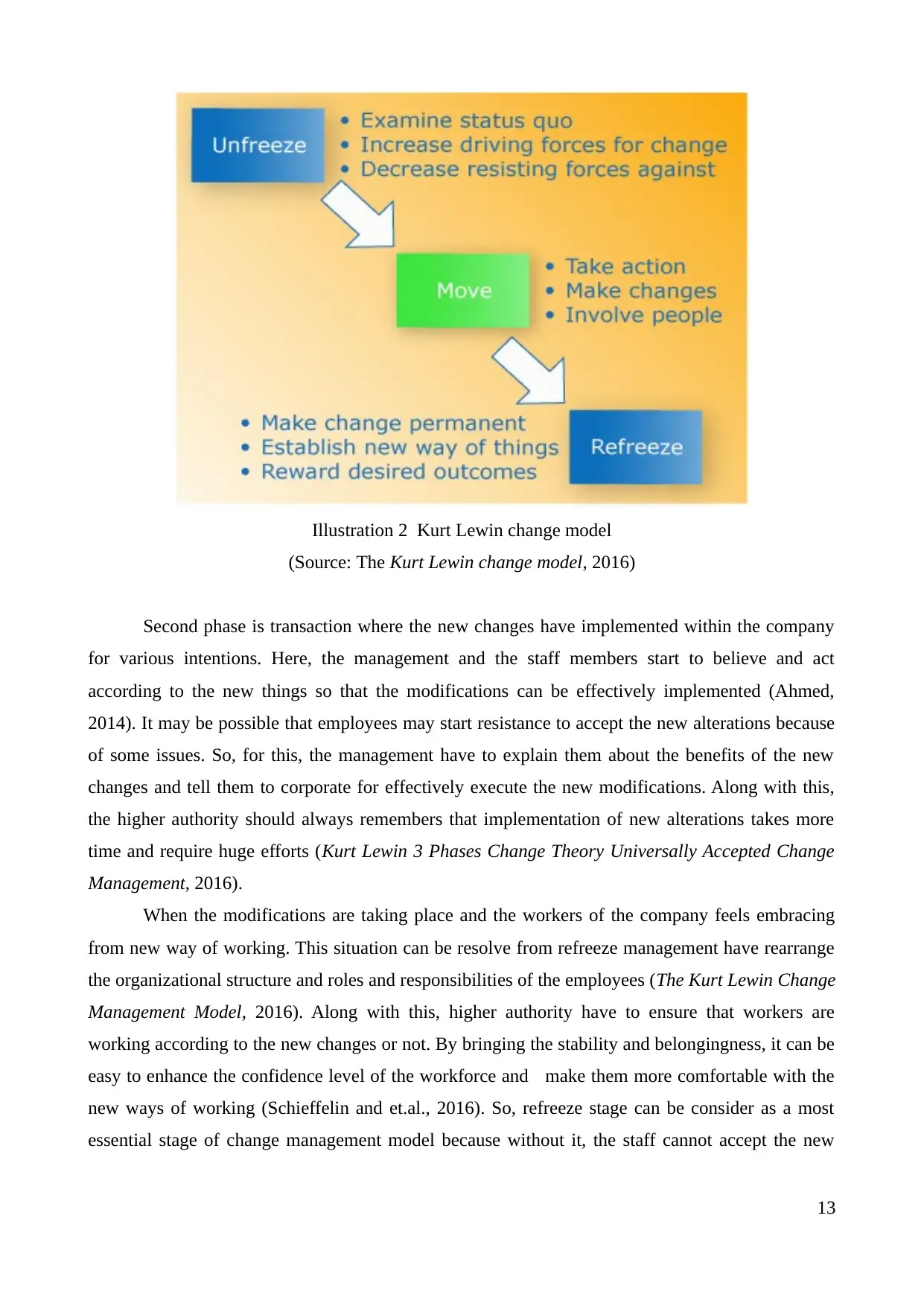
Second phase is transaction where the new changes have implemented within the company
for various intentions. Here, the management and the staff members start to believe and act
according to the new things so that the modifications can be effectively implemented (Ahmed,
2014). It may be possible that employees may start resistance to accept the new alterations because
of some issues. So, for this, the management have to explain them about the benefits of the new
changes and tell them to corporate for effectively execute the new modifications. Along with this,
the higher authority should always remembers that implementation of new alterations takes more
time and require huge efforts (Kurt Lewin 3 Phases Change Theory Universally Accepted Change
Management, 2016).
When the modifications are taking place and the workers of the company feels embracing
from new way of working. This situation can be resolve from refreeze management have rearrange
the organizational structure and roles and responsibilities of the employees (The Kurt Lewin Change
Management Model, 2016). Along with this, higher authority have to ensure that workers are
working according to the new changes or not. By bringing the stability and belongingness, it can be
easy to enhance the confidence level of the workforce and make them more comfortable with the
new ways of working (Schieffelin and et.al., 2016). So, refreeze stage can be consider as a most
essential stage of change management model because without it, the staff cannot accept the new
13
Illustration 2 Kurt Lewin change model
(Source: The Kurt Lewin change model, 2016)
for various intentions. Here, the management and the staff members start to believe and act
according to the new things so that the modifications can be effectively implemented (Ahmed,
2014). It may be possible that employees may start resistance to accept the new alterations because
of some issues. So, for this, the management have to explain them about the benefits of the new
changes and tell them to corporate for effectively execute the new modifications. Along with this,
the higher authority should always remembers that implementation of new alterations takes more
time and require huge efforts (Kurt Lewin 3 Phases Change Theory Universally Accepted Change
Management, 2016).
When the modifications are taking place and the workers of the company feels embracing
from new way of working. This situation can be resolve from refreeze management have rearrange
the organizational structure and roles and responsibilities of the employees (The Kurt Lewin Change
Management Model, 2016). Along with this, higher authority have to ensure that workers are
working according to the new changes or not. By bringing the stability and belongingness, it can be
easy to enhance the confidence level of the workforce and make them more comfortable with the
new ways of working (Schieffelin and et.al., 2016). So, refreeze stage can be consider as a most
essential stage of change management model because without it, the staff cannot accept the new
13
Illustration 2 Kurt Lewin change model
(Source: The Kurt Lewin change model, 2016)
Paraphrase This Document
Need a fresh take? Get an instant paraphrase of this document with our AI Paraphraser
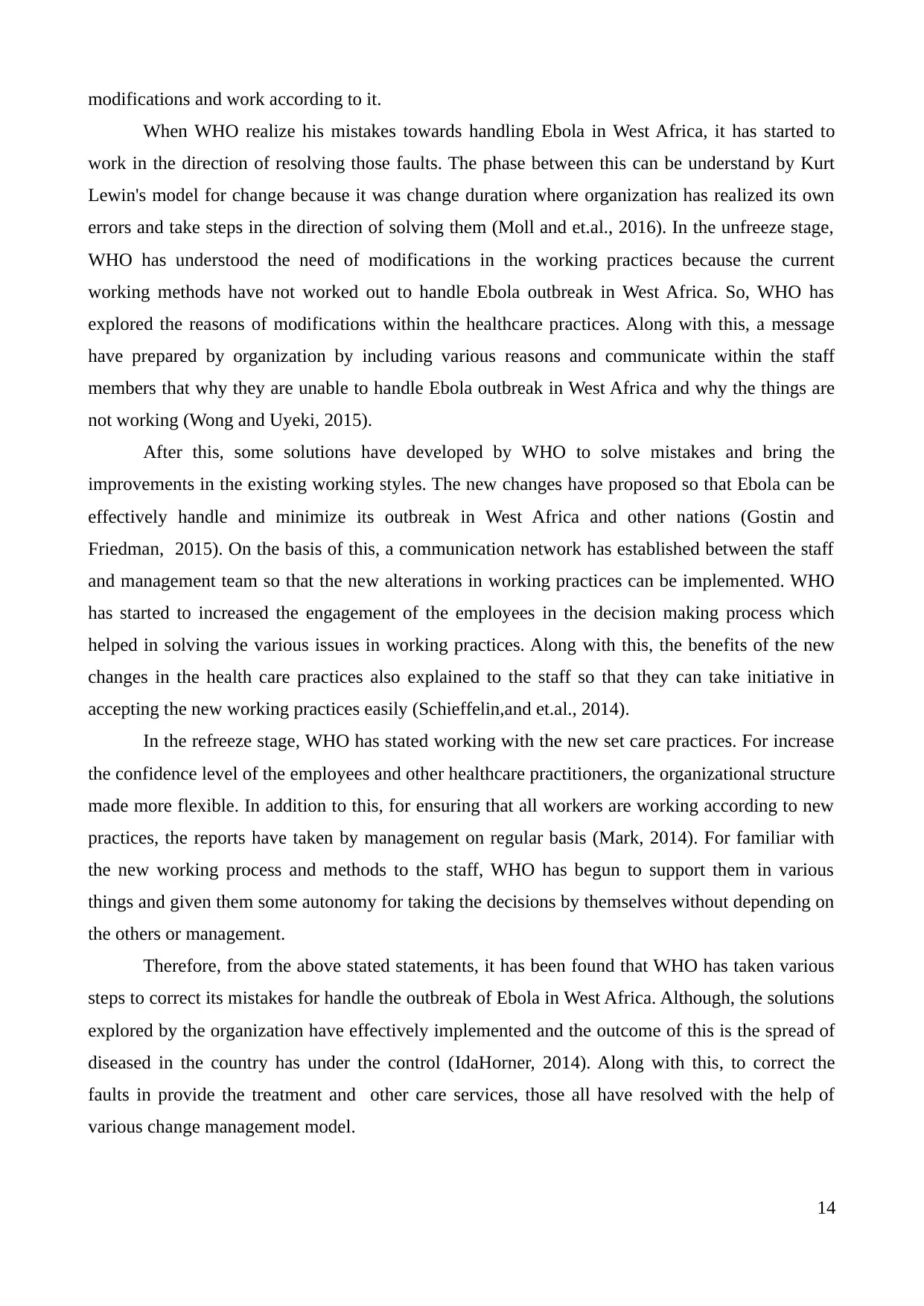
modifications and work according to it.
When WHO realize his mistakes towards handling Ebola in West Africa, it has started to
work in the direction of resolving those faults. The phase between this can be understand by Kurt
Lewin's model for change because it was change duration where organization has realized its own
errors and take steps in the direction of solving them (Moll and et.al., 2016). In the unfreeze stage,
WHO has understood the need of modifications in the working practices because the current
working methods have not worked out to handle Ebola outbreak in West Africa. So, WHO has
explored the reasons of modifications within the healthcare practices. Along with this, a message
have prepared by organization by including various reasons and communicate within the staff
members that why they are unable to handle Ebola outbreak in West Africa and why the things are
not working (Wong and Uyeki, 2015).
After this, some solutions have developed by WHO to solve mistakes and bring the
improvements in the existing working styles. The new changes have proposed so that Ebola can be
effectively handle and minimize its outbreak in West Africa and other nations (Gostin and
Friedman, 2015). On the basis of this, a communication network has established between the staff
and management team so that the new alterations in working practices can be implemented. WHO
has started to increased the engagement of the employees in the decision making process which
helped in solving the various issues in working practices. Along with this, the benefits of the new
changes in the health care practices also explained to the staff so that they can take initiative in
accepting the new working practices easily (Schieffelin,and et.al., 2014).
In the refreeze stage, WHO has stated working with the new set care practices. For increase
the confidence level of the employees and other healthcare practitioners, the organizational structure
made more flexible. In addition to this, for ensuring that all workers are working according to new
practices, the reports have taken by management on regular basis (Mark, 2014). For familiar with
the new working process and methods to the staff, WHO has begun to support them in various
things and given them some autonomy for taking the decisions by themselves without depending on
the others or management.
Therefore, from the above stated statements, it has been found that WHO has taken various
steps to correct its mistakes for handle the outbreak of Ebola in West Africa. Although, the solutions
explored by the organization have effectively implemented and the outcome of this is the spread of
diseased in the country has under the control (IdaHorner, 2014). Along with this, to correct the
faults in provide the treatment and other care services, those all have resolved with the help of
various change management model.
14
When WHO realize his mistakes towards handling Ebola in West Africa, it has started to
work in the direction of resolving those faults. The phase between this can be understand by Kurt
Lewin's model for change because it was change duration where organization has realized its own
errors and take steps in the direction of solving them (Moll and et.al., 2016). In the unfreeze stage,
WHO has understood the need of modifications in the working practices because the current
working methods have not worked out to handle Ebola outbreak in West Africa. So, WHO has
explored the reasons of modifications within the healthcare practices. Along with this, a message
have prepared by organization by including various reasons and communicate within the staff
members that why they are unable to handle Ebola outbreak in West Africa and why the things are
not working (Wong and Uyeki, 2015).
After this, some solutions have developed by WHO to solve mistakes and bring the
improvements in the existing working styles. The new changes have proposed so that Ebola can be
effectively handle and minimize its outbreak in West Africa and other nations (Gostin and
Friedman, 2015). On the basis of this, a communication network has established between the staff
and management team so that the new alterations in working practices can be implemented. WHO
has started to increased the engagement of the employees in the decision making process which
helped in solving the various issues in working practices. Along with this, the benefits of the new
changes in the health care practices also explained to the staff so that they can take initiative in
accepting the new working practices easily (Schieffelin,and et.al., 2014).
In the refreeze stage, WHO has stated working with the new set care practices. For increase
the confidence level of the employees and other healthcare practitioners, the organizational structure
made more flexible. In addition to this, for ensuring that all workers are working according to new
practices, the reports have taken by management on regular basis (Mark, 2014). For familiar with
the new working process and methods to the staff, WHO has begun to support them in various
things and given them some autonomy for taking the decisions by themselves without depending on
the others or management.
Therefore, from the above stated statements, it has been found that WHO has taken various
steps to correct its mistakes for handle the outbreak of Ebola in West Africa. Although, the solutions
explored by the organization have effectively implemented and the outcome of this is the spread of
diseased in the country has under the control (IdaHorner, 2014). Along with this, to correct the
faults in provide the treatment and other care services, those all have resolved with the help of
various change management model.
14
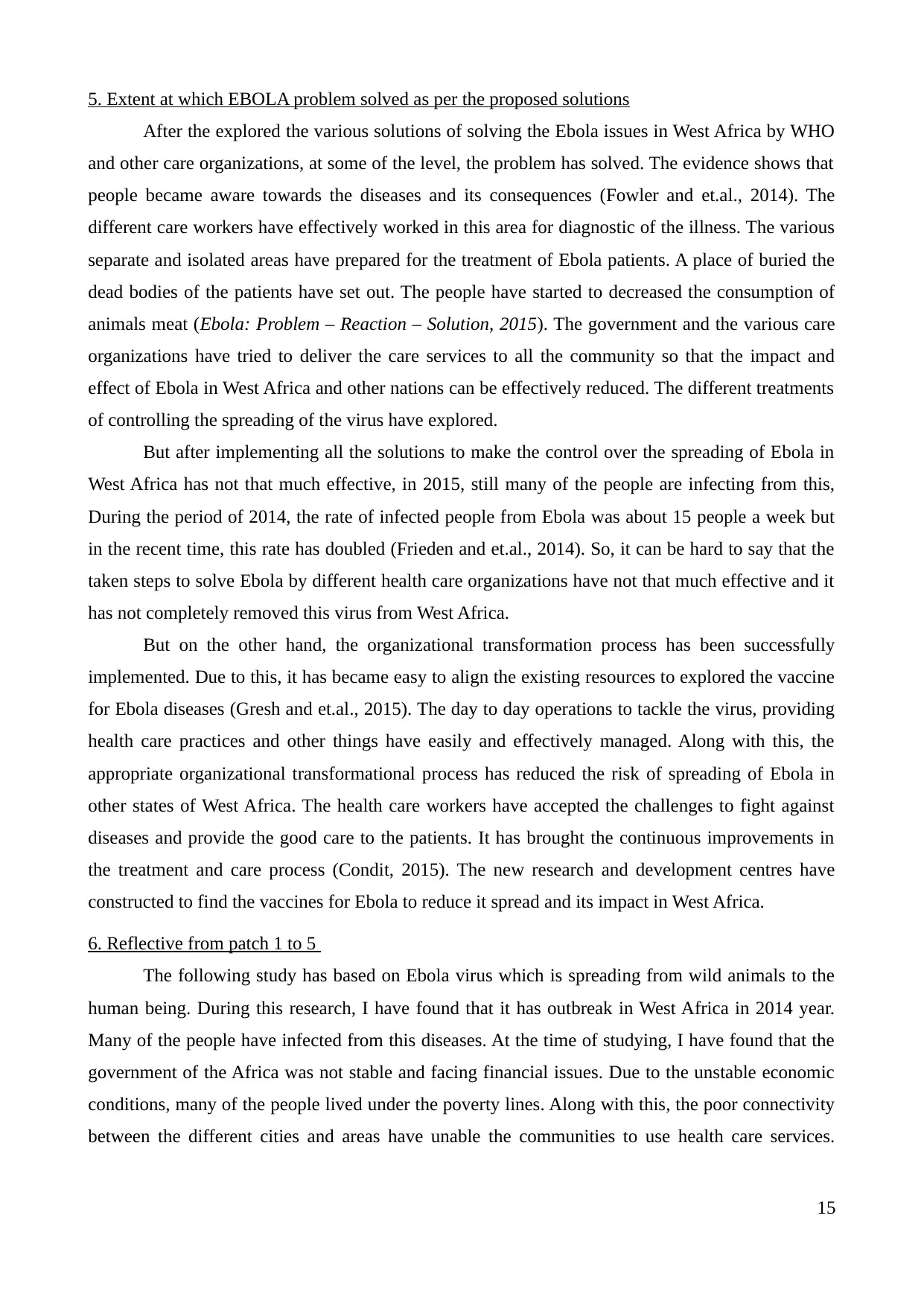
5. Extent at which EBOLA problem solved as per the proposed solutions
After the explored the various solutions of solving the Ebola issues in West Africa by WHO
and other care organizations, at some of the level, the problem has solved. The evidence shows that
people became aware towards the diseases and its consequences (Fowler and et.al., 2014). The
different care workers have effectively worked in this area for diagnostic of the illness. The various
separate and isolated areas have prepared for the treatment of Ebola patients. A place of buried the
dead bodies of the patients have set out. The people have started to decreased the consumption of
animals meat (Ebola: Problem – Reaction – Solution, 2015). The government and the various care
organizations have tried to deliver the care services to all the community so that the impact and
effect of Ebola in West Africa and other nations can be effectively reduced. The different treatments
of controlling the spreading of the virus have explored.
But after implementing all the solutions to make the control over the spreading of Ebola in
West Africa has not that much effective, in 2015, still many of the people are infecting from this,
During the period of 2014, the rate of infected people from Ebola was about 15 people a week but
in the recent time, this rate has doubled (Frieden and et.al., 2014). So, it can be hard to say that the
taken steps to solve Ebola by different health care organizations have not that much effective and it
has not completely removed this virus from West Africa.
But on the other hand, the organizational transformation process has been successfully
implemented. Due to this, it has became easy to align the existing resources to explored the vaccine
for Ebola diseases (Gresh and et.al., 2015). The day to day operations to tackle the virus, providing
health care practices and other things have easily and effectively managed. Along with this, the
appropriate organizational transformational process has reduced the risk of spreading of Ebola in
other states of West Africa. The health care workers have accepted the challenges to fight against
diseases and provide the good care to the patients. It has brought the continuous improvements in
the treatment and care process (Condit, 2015). The new research and development centres have
constructed to find the vaccines for Ebola to reduce it spread and its impact in West Africa.
6. Reflective from patch 1 to 5
The following study has based on Ebola virus which is spreading from wild animals to the
human being. During this research, I have found that it has outbreak in West Africa in 2014 year.
Many of the people have infected from this diseases. At the time of studying, I have found that the
government of the Africa was not stable and facing financial issues. Due to the unstable economic
conditions, many of the people lived under the poverty lines. Along with this, the poor connectivity
between the different cities and areas have unable the communities to use health care services.
15
After the explored the various solutions of solving the Ebola issues in West Africa by WHO
and other care organizations, at some of the level, the problem has solved. The evidence shows that
people became aware towards the diseases and its consequences (Fowler and et.al., 2014). The
different care workers have effectively worked in this area for diagnostic of the illness. The various
separate and isolated areas have prepared for the treatment of Ebola patients. A place of buried the
dead bodies of the patients have set out. The people have started to decreased the consumption of
animals meat (Ebola: Problem – Reaction – Solution, 2015). The government and the various care
organizations have tried to deliver the care services to all the community so that the impact and
effect of Ebola in West Africa and other nations can be effectively reduced. The different treatments
of controlling the spreading of the virus have explored.
But after implementing all the solutions to make the control over the spreading of Ebola in
West Africa has not that much effective, in 2015, still many of the people are infecting from this,
During the period of 2014, the rate of infected people from Ebola was about 15 people a week but
in the recent time, this rate has doubled (Frieden and et.al., 2014). So, it can be hard to say that the
taken steps to solve Ebola by different health care organizations have not that much effective and it
has not completely removed this virus from West Africa.
But on the other hand, the organizational transformation process has been successfully
implemented. Due to this, it has became easy to align the existing resources to explored the vaccine
for Ebola diseases (Gresh and et.al., 2015). The day to day operations to tackle the virus, providing
health care practices and other things have easily and effectively managed. Along with this, the
appropriate organizational transformational process has reduced the risk of spreading of Ebola in
other states of West Africa. The health care workers have accepted the challenges to fight against
diseases and provide the good care to the patients. It has brought the continuous improvements in
the treatment and care process (Condit, 2015). The new research and development centres have
constructed to find the vaccines for Ebola to reduce it spread and its impact in West Africa.
6. Reflective from patch 1 to 5
The following study has based on Ebola virus which is spreading from wild animals to the
human being. During this research, I have found that it has outbreak in West Africa in 2014 year.
Many of the people have infected from this diseases. At the time of studying, I have found that the
government of the Africa was not stable and facing financial issues. Due to the unstable economic
conditions, many of the people lived under the poverty lines. Along with this, the poor connectivity
between the different cities and areas have unable the communities to use health care services.
15
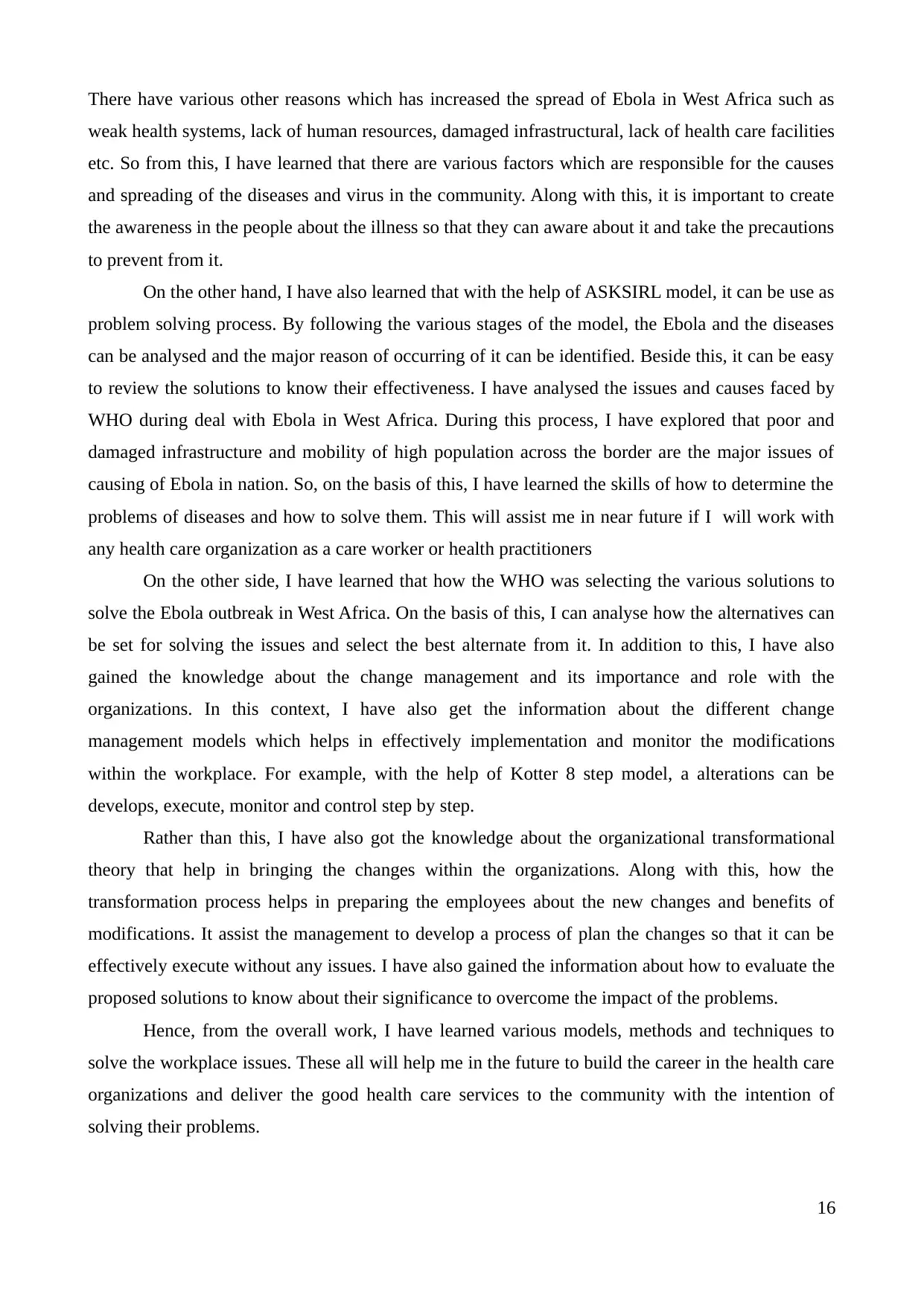
There have various other reasons which has increased the spread of Ebola in West Africa such as
weak health systems, lack of human resources, damaged infrastructural, lack of health care facilities
etc. So from this, I have learned that there are various factors which are responsible for the causes
and spreading of the diseases and virus in the community. Along with this, it is important to create
the awareness in the people about the illness so that they can aware about it and take the precautions
to prevent from it.
On the other hand, I have also learned that with the help of ASKSIRL model, it can be use as
problem solving process. By following the various stages of the model, the Ebola and the diseases
can be analysed and the major reason of occurring of it can be identified. Beside this, it can be easy
to review the solutions to know their effectiveness. I have analysed the issues and causes faced by
WHO during deal with Ebola in West Africa. During this process, I have explored that poor and
damaged infrastructure and mobility of high population across the border are the major issues of
causing of Ebola in nation. So, on the basis of this, I have learned the skills of how to determine the
problems of diseases and how to solve them. This will assist me in near future if I will work with
any health care organization as a care worker or health practitioners
On the other side, I have learned that how the WHO was selecting the various solutions to
solve the Ebola outbreak in West Africa. On the basis of this, I can analyse how the alternatives can
be set for solving the issues and select the best alternate from it. In addition to this, I have also
gained the knowledge about the change management and its importance and role with the
organizations. In this context, I have also get the information about the different change
management models which helps in effectively implementation and monitor the modifications
within the workplace. For example, with the help of Kotter 8 step model, a alterations can be
develops, execute, monitor and control step by step.
Rather than this, I have also got the knowledge about the organizational transformational
theory that help in bringing the changes within the organizations. Along with this, how the
transformation process helps in preparing the employees about the new changes and benefits of
modifications. It assist the management to develop a process of plan the changes so that it can be
effectively execute without any issues. I have also gained the information about how to evaluate the
proposed solutions to know about their significance to overcome the impact of the problems.
Hence, from the overall work, I have learned various models, methods and techniques to
solve the workplace issues. These all will help me in the future to build the career in the health care
organizations and deliver the good health care services to the community with the intention of
solving their problems.
16
weak health systems, lack of human resources, damaged infrastructural, lack of health care facilities
etc. So from this, I have learned that there are various factors which are responsible for the causes
and spreading of the diseases and virus in the community. Along with this, it is important to create
the awareness in the people about the illness so that they can aware about it and take the precautions
to prevent from it.
On the other hand, I have also learned that with the help of ASKSIRL model, it can be use as
problem solving process. By following the various stages of the model, the Ebola and the diseases
can be analysed and the major reason of occurring of it can be identified. Beside this, it can be easy
to review the solutions to know their effectiveness. I have analysed the issues and causes faced by
WHO during deal with Ebola in West Africa. During this process, I have explored that poor and
damaged infrastructure and mobility of high population across the border are the major issues of
causing of Ebola in nation. So, on the basis of this, I have learned the skills of how to determine the
problems of diseases and how to solve them. This will assist me in near future if I will work with
any health care organization as a care worker or health practitioners
On the other side, I have learned that how the WHO was selecting the various solutions to
solve the Ebola outbreak in West Africa. On the basis of this, I can analyse how the alternatives can
be set for solving the issues and select the best alternate from it. In addition to this, I have also
gained the knowledge about the change management and its importance and role with the
organizations. In this context, I have also get the information about the different change
management models which helps in effectively implementation and monitor the modifications
within the workplace. For example, with the help of Kotter 8 step model, a alterations can be
develops, execute, monitor and control step by step.
Rather than this, I have also got the knowledge about the organizational transformational
theory that help in bringing the changes within the organizations. Along with this, how the
transformation process helps in preparing the employees about the new changes and benefits of
modifications. It assist the management to develop a process of plan the changes so that it can be
effectively execute without any issues. I have also gained the information about how to evaluate the
proposed solutions to know about their significance to overcome the impact of the problems.
Hence, from the overall work, I have learned various models, methods and techniques to
solve the workplace issues. These all will help me in the future to build the career in the health care
organizations and deliver the good health care services to the community with the intention of
solving their problems.
16
Secure Best Marks with AI Grader
Need help grading? Try our AI Grader for instant feedback on your assignments.
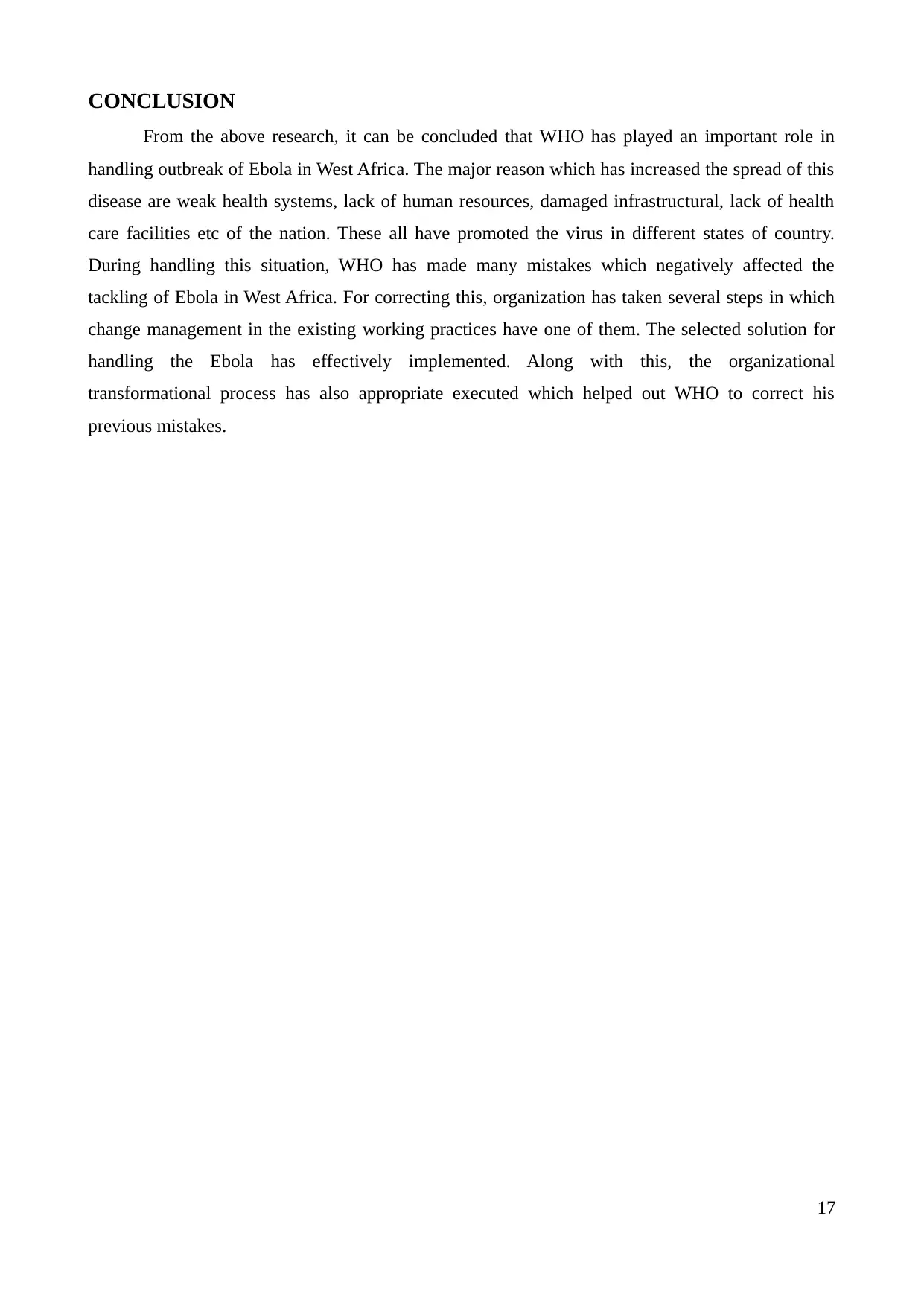
CONCLUSION
From the above research, it can be concluded that WHO has played an important role in
handling outbreak of Ebola in West Africa. The major reason which has increased the spread of this
disease are weak health systems, lack of human resources, damaged infrastructural, lack of health
care facilities etc of the nation. These all have promoted the virus in different states of country.
During handling this situation, WHO has made many mistakes which negatively affected the
tackling of Ebola in West Africa. For correcting this, organization has taken several steps in which
change management in the existing working practices have one of them. The selected solution for
handling the Ebola has effectively implemented. Along with this, the organizational
transformational process has also appropriate executed which helped out WHO to correct his
previous mistakes.
17
From the above research, it can be concluded that WHO has played an important role in
handling outbreak of Ebola in West Africa. The major reason which has increased the spread of this
disease are weak health systems, lack of human resources, damaged infrastructural, lack of health
care facilities etc of the nation. These all have promoted the virus in different states of country.
During handling this situation, WHO has made many mistakes which negatively affected the
tackling of Ebola in West Africa. For correcting this, organization has taken several steps in which
change management in the existing working practices have one of them. The selected solution for
handling the Ebola has effectively implemented. Along with this, the organizational
transformational process has also appropriate executed which helped out WHO to correct his
previous mistakes.
17
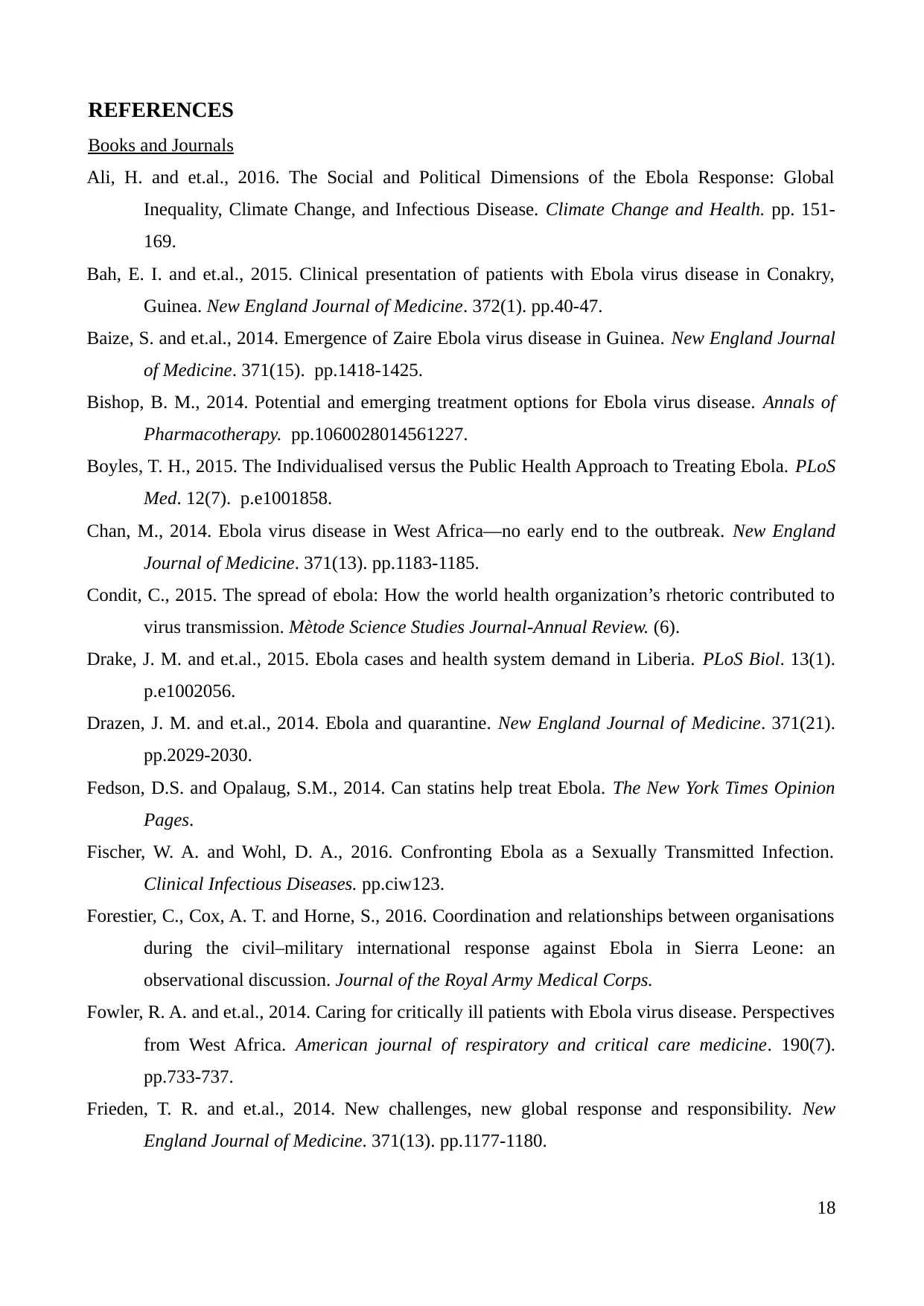
REFERENCES
Books and Journals
Ali, H. and et.al., 2016. The Social and Political Dimensions of the Ebola Response: Global
Inequality, Climate Change, and Infectious Disease. Climate Change and Health. pp. 151-
169.
Bah, E. I. and et.al., 2015. Clinical presentation of patients with Ebola virus disease in Conakry,
Guinea. New England Journal of Medicine. 372(1). pp.40-47.
Baize, S. and et.al., 2014. Emergence of Zaire Ebola virus disease in Guinea. New England Journal
of Medicine. 371(15). pp.1418-1425.
Bishop, B. M., 2014. Potential and emerging treatment options for Ebola virus disease. Annals of
Pharmacotherapy. pp.1060028014561227.
Boyles, T. H., 2015. The Individualised versus the Public Health Approach to Treating Ebola. PLoS
Med. 12(7). p.e1001858.
Chan, M., 2014. Ebola virus disease in West Africa—no early end to the outbreak. New England
Journal of Medicine. 371(13). pp.1183-1185.
Condit, C., 2015. The spread of ebola: How the world health organization’s rhetoric contributed to
virus transmission. Mètode Science Studies Journal-Annual Review. (6).
Drake, J. M. and et.al., 2015. Ebola cases and health system demand in Liberia. PLoS Biol. 13(1).
p.e1002056.
Drazen, J. M. and et.al., 2014. Ebola and quarantine. New England Journal of Medicine. 371(21).
pp.2029-2030.
Fedson, D.S. and Opalaug, S.M., 2014. Can statins help treat Ebola. The New York Times Opinion
Pages.
Fischer, W. A. and Wohl, D. A., 2016. Confronting Ebola as a Sexually Transmitted Infection.
Clinical Infectious Diseases. pp.ciw123.
Forestier, C., Cox, A. T. and Horne, S., 2016. Coordination and relationships between organisations
during the civil–military international response against Ebola in Sierra Leone: an
observational discussion. Journal of the Royal Army Medical Corps.
Fowler, R. A. and et.al., 2014. Caring for critically ill patients with Ebola virus disease. Perspectives
from West Africa. American journal of respiratory and critical care medicine. 190(7).
pp.733-737.
Frieden, T. R. and et.al., 2014. New challenges, new global response and responsibility. New
England Journal of Medicine. 371(13). pp.1177-1180.
18
Books and Journals
Ali, H. and et.al., 2016. The Social and Political Dimensions of the Ebola Response: Global
Inequality, Climate Change, and Infectious Disease. Climate Change and Health. pp. 151-
169.
Bah, E. I. and et.al., 2015. Clinical presentation of patients with Ebola virus disease in Conakry,
Guinea. New England Journal of Medicine. 372(1). pp.40-47.
Baize, S. and et.al., 2014. Emergence of Zaire Ebola virus disease in Guinea. New England Journal
of Medicine. 371(15). pp.1418-1425.
Bishop, B. M., 2014. Potential and emerging treatment options for Ebola virus disease. Annals of
Pharmacotherapy. pp.1060028014561227.
Boyles, T. H., 2015. The Individualised versus the Public Health Approach to Treating Ebola. PLoS
Med. 12(7). p.e1001858.
Chan, M., 2014. Ebola virus disease in West Africa—no early end to the outbreak. New England
Journal of Medicine. 371(13). pp.1183-1185.
Condit, C., 2015. The spread of ebola: How the world health organization’s rhetoric contributed to
virus transmission. Mètode Science Studies Journal-Annual Review. (6).
Drake, J. M. and et.al., 2015. Ebola cases and health system demand in Liberia. PLoS Biol. 13(1).
p.e1002056.
Drazen, J. M. and et.al., 2014. Ebola and quarantine. New England Journal of Medicine. 371(21).
pp.2029-2030.
Fedson, D.S. and Opalaug, S.M., 2014. Can statins help treat Ebola. The New York Times Opinion
Pages.
Fischer, W. A. and Wohl, D. A., 2016. Confronting Ebola as a Sexually Transmitted Infection.
Clinical Infectious Diseases. pp.ciw123.
Forestier, C., Cox, A. T. and Horne, S., 2016. Coordination and relationships between organisations
during the civil–military international response against Ebola in Sierra Leone: an
observational discussion. Journal of the Royal Army Medical Corps.
Fowler, R. A. and et.al., 2014. Caring for critically ill patients with Ebola virus disease. Perspectives
from West Africa. American journal of respiratory and critical care medicine. 190(7).
pp.733-737.
Frieden, T. R. and et.al., 2014. New challenges, new global response and responsibility. New
England Journal of Medicine. 371(13). pp.1177-1180.
18
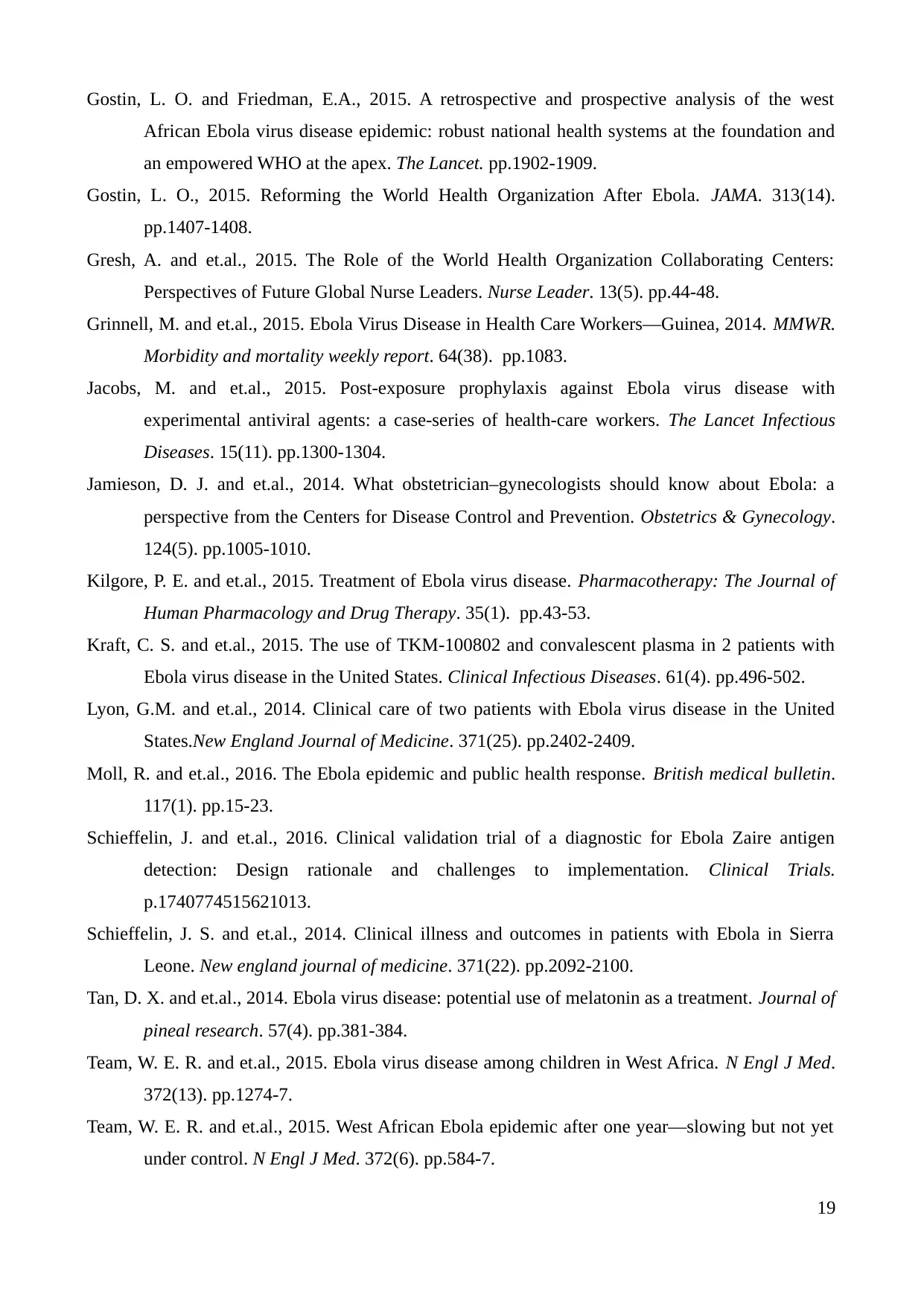
Gostin, L. O. and Friedman, E.A., 2015. A retrospective and prospective analysis of the west
African Ebola virus disease epidemic: robust national health systems at the foundation and
an empowered WHO at the apex. The Lancet. pp.1902-1909.
Gostin, L. O., 2015. Reforming the World Health Organization After Ebola. JAMA. 313(14).
pp.1407-1408.
Gresh, A. and et.al., 2015. The Role of the World Health Organization Collaborating Centers:
Perspectives of Future Global Nurse Leaders. Nurse Leader. 13(5). pp.44-48.
Grinnell, M. and et.al., 2015. Ebola Virus Disease in Health Care Workers—Guinea, 2014. MMWR.
Morbidity and mortality weekly report. 64(38). pp.1083.
Jacobs, M. and et.al., 2015. Post-exposure prophylaxis against Ebola virus disease with
experimental antiviral agents: a case-series of health-care workers. The Lancet Infectious
Diseases. 15(11). pp.1300-1304.
Jamieson, D. J. and et.al., 2014. What obstetrician–gynecologists should know about Ebola: a
perspective from the Centers for Disease Control and Prevention. Obstetrics & Gynecology.
124(5). pp.1005-1010.
Kilgore, P. E. and et.al., 2015. Treatment of Ebola virus disease. Pharmacotherapy: The Journal of
Human Pharmacology and Drug Therapy. 35(1). pp.43-53.
Kraft, C. S. and et.al., 2015. The use of TKM-100802 and convalescent plasma in 2 patients with
Ebola virus disease in the United States. Clinical Infectious Diseases. 61(4). pp.496-502.
Lyon, G.M. and et.al., 2014. Clinical care of two patients with Ebola virus disease in the United
States.New England Journal of Medicine. 371(25). pp.2402-2409.
Moll, R. and et.al., 2016. The Ebola epidemic and public health response. British medical bulletin.
117(1). pp.15-23.
Schieffelin, J. and et.al., 2016. Clinical validation trial of a diagnostic for Ebola Zaire antigen
detection: Design rationale and challenges to implementation. Clinical Trials.
p.1740774515621013.
Schieffelin, J. S. and et.al., 2014. Clinical illness and outcomes in patients with Ebola in Sierra
Leone. New england journal of medicine. 371(22). pp.2092-2100.
Tan, D. X. and et.al., 2014. Ebola virus disease: potential use of melatonin as a treatment. Journal of
pineal research. 57(4). pp.381-384.
Team, W. E. R. and et.al., 2015. Ebola virus disease among children in West Africa. N Engl J Med.
372(13). pp.1274-7.
Team, W. E. R. and et.al., 2015. West African Ebola epidemic after one year—slowing but not yet
under control. N Engl J Med. 372(6). pp.584-7.
19
African Ebola virus disease epidemic: robust national health systems at the foundation and
an empowered WHO at the apex. The Lancet. pp.1902-1909.
Gostin, L. O., 2015. Reforming the World Health Organization After Ebola. JAMA. 313(14).
pp.1407-1408.
Gresh, A. and et.al., 2015. The Role of the World Health Organization Collaborating Centers:
Perspectives of Future Global Nurse Leaders. Nurse Leader. 13(5). pp.44-48.
Grinnell, M. and et.al., 2015. Ebola Virus Disease in Health Care Workers—Guinea, 2014. MMWR.
Morbidity and mortality weekly report. 64(38). pp.1083.
Jacobs, M. and et.al., 2015. Post-exposure prophylaxis against Ebola virus disease with
experimental antiviral agents: a case-series of health-care workers. The Lancet Infectious
Diseases. 15(11). pp.1300-1304.
Jamieson, D. J. and et.al., 2014. What obstetrician–gynecologists should know about Ebola: a
perspective from the Centers for Disease Control and Prevention. Obstetrics & Gynecology.
124(5). pp.1005-1010.
Kilgore, P. E. and et.al., 2015. Treatment of Ebola virus disease. Pharmacotherapy: The Journal of
Human Pharmacology and Drug Therapy. 35(1). pp.43-53.
Kraft, C. S. and et.al., 2015. The use of TKM-100802 and convalescent plasma in 2 patients with
Ebola virus disease in the United States. Clinical Infectious Diseases. 61(4). pp.496-502.
Lyon, G.M. and et.al., 2014. Clinical care of two patients with Ebola virus disease in the United
States.New England Journal of Medicine. 371(25). pp.2402-2409.
Moll, R. and et.al., 2016. The Ebola epidemic and public health response. British medical bulletin.
117(1). pp.15-23.
Schieffelin, J. and et.al., 2016. Clinical validation trial of a diagnostic for Ebola Zaire antigen
detection: Design rationale and challenges to implementation. Clinical Trials.
p.1740774515621013.
Schieffelin, J. S. and et.al., 2014. Clinical illness and outcomes in patients with Ebola in Sierra
Leone. New england journal of medicine. 371(22). pp.2092-2100.
Tan, D. X. and et.al., 2014. Ebola virus disease: potential use of melatonin as a treatment. Journal of
pineal research. 57(4). pp.381-384.
Team, W. E. R. and et.al., 2015. Ebola virus disease among children in West Africa. N Engl J Med.
372(13). pp.1274-7.
Team, W. E. R. and et.al., 2015. West African Ebola epidemic after one year—slowing but not yet
under control. N Engl J Med. 372(6). pp.584-7.
19
Paraphrase This Document
Need a fresh take? Get an instant paraphrase of this document with our AI Paraphraser
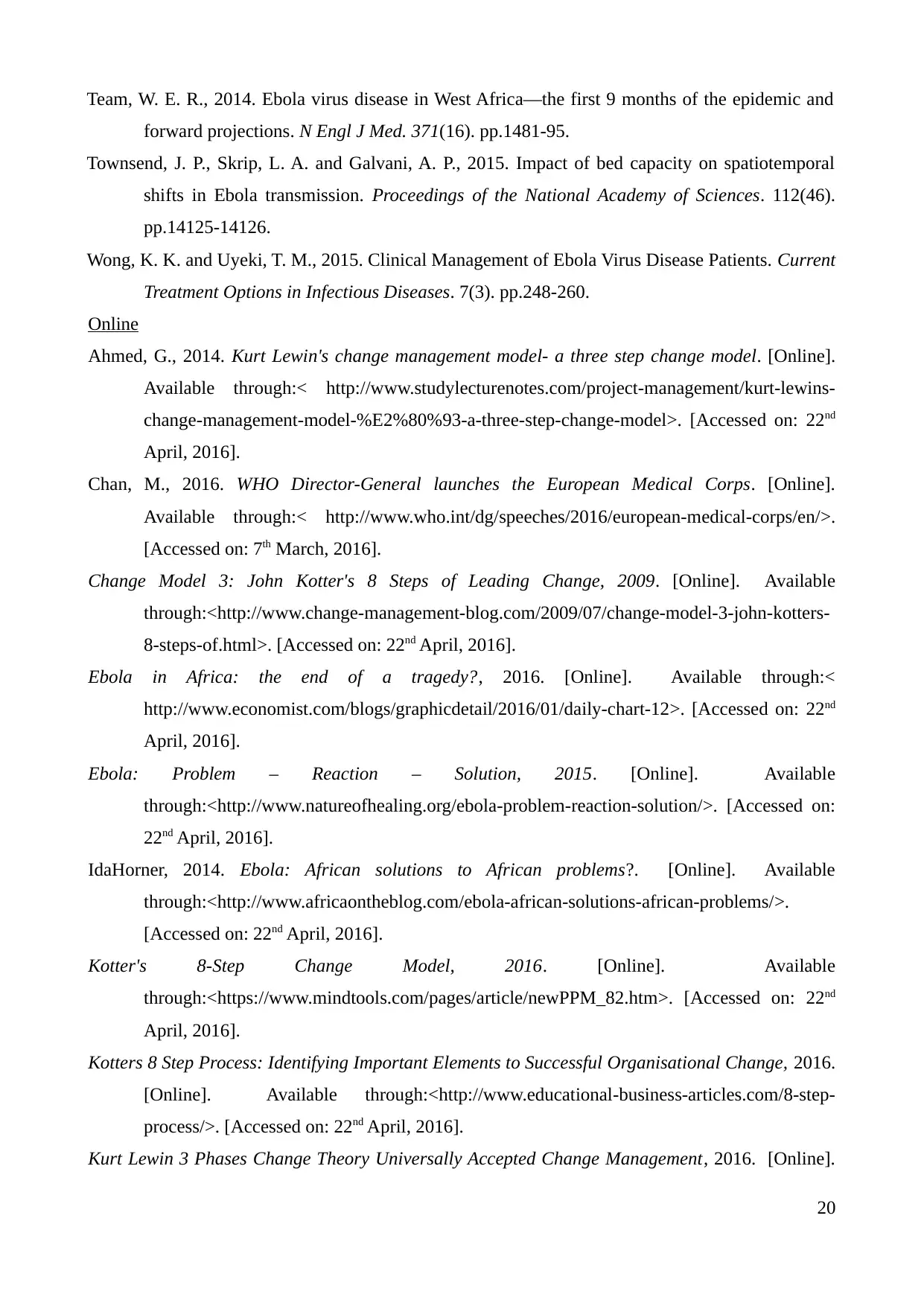
Team, W. E. R., 2014. Ebola virus disease in West Africa—the first 9 months of the epidemic and
forward projections. N Engl J Med. 371(16). pp.1481-95.
Townsend, J. P., Skrip, L. A. and Galvani, A. P., 2015. Impact of bed capacity on spatiotemporal
shifts in Ebola transmission. Proceedings of the National Academy of Sciences. 112(46).
pp.14125-14126.
Wong, K. K. and Uyeki, T. M., 2015. Clinical Management of Ebola Virus Disease Patients. Current
Treatment Options in Infectious Diseases. 7(3). pp.248-260.
Online
Ahmed, G., 2014. Kurt Lewin's change management model- a three step change model. [Online].
Available through:< http://www.studylecturenotes.com/project-management/kurt-lewins-
change-management-model-%E2%80%93-a-three-step-change-model>. [Accessed on: 22nd
April, 2016].
Chan, M., 2016. WHO Director-General launches the European Medical Corps. [Online].
Available through:< http://www.who.int/dg/speeches/2016/european-medical-corps/en/>.
[Accessed on: 7th March, 2016].
Change Model 3: John Kotter's 8 Steps of Leading Change, 2009. [Online]. Available
through:<http://www.change-management-blog.com/2009/07/change-model-3-john-kotters-
8-steps-of.html>. [Accessed on: 22nd April, 2016].
Ebola in Africa: the end of a tragedy?, 2016. [Online]. Available through:<
http://www.economist.com/blogs/graphicdetail/2016/01/daily-chart-12>. [Accessed on: 22nd
April, 2016].
Ebola: Problem – Reaction – Solution, 2015. [Online]. Available
through:<http://www.natureofhealing.org/ebola-problem-reaction-solution/>. [Accessed on:
22nd April, 2016].
IdaHorner, 2014. Ebola: African solutions to African problems?. [Online]. Available
through:<http://www.africaontheblog.com/ebola-african-solutions-african-problems/>.
[Accessed on: 22nd April, 2016].
Kotter's 8-Step Change Model, 2016. [Online]. Available
through:<https://www.mindtools.com/pages/article/newPPM_82.htm>. [Accessed on: 22nd
April, 2016].
Kotters 8 Step Process: Identifying Important Elements to Successful Organisational Change, 2016.
[Online]. Available through:<http://www.educational-business-articles.com/8-step-
process/>. [Accessed on: 22nd April, 2016].
Kurt Lewin 3 Phases Change Theory Universally Accepted Change Management, 2016. [Online].
20
forward projections. N Engl J Med. 371(16). pp.1481-95.
Townsend, J. P., Skrip, L. A. and Galvani, A. P., 2015. Impact of bed capacity on spatiotemporal
shifts in Ebola transmission. Proceedings of the National Academy of Sciences. 112(46).
pp.14125-14126.
Wong, K. K. and Uyeki, T. M., 2015. Clinical Management of Ebola Virus Disease Patients. Current
Treatment Options in Infectious Diseases. 7(3). pp.248-260.
Online
Ahmed, G., 2014. Kurt Lewin's change management model- a three step change model. [Online].
Available through:< http://www.studylecturenotes.com/project-management/kurt-lewins-
change-management-model-%E2%80%93-a-three-step-change-model>. [Accessed on: 22nd
April, 2016].
Chan, M., 2016. WHO Director-General launches the European Medical Corps. [Online].
Available through:< http://www.who.int/dg/speeches/2016/european-medical-corps/en/>.
[Accessed on: 7th March, 2016].
Change Model 3: John Kotter's 8 Steps of Leading Change, 2009. [Online]. Available
through:<http://www.change-management-blog.com/2009/07/change-model-3-john-kotters-
8-steps-of.html>. [Accessed on: 22nd April, 2016].
Ebola in Africa: the end of a tragedy?, 2016. [Online]. Available through:<
http://www.economist.com/blogs/graphicdetail/2016/01/daily-chart-12>. [Accessed on: 22nd
April, 2016].
Ebola: Problem – Reaction – Solution, 2015. [Online]. Available
through:<http://www.natureofhealing.org/ebola-problem-reaction-solution/>. [Accessed on:
22nd April, 2016].
IdaHorner, 2014. Ebola: African solutions to African problems?. [Online]. Available
through:<http://www.africaontheblog.com/ebola-african-solutions-african-problems/>.
[Accessed on: 22nd April, 2016].
Kotter's 8-Step Change Model, 2016. [Online]. Available
through:<https://www.mindtools.com/pages/article/newPPM_82.htm>. [Accessed on: 22nd
April, 2016].
Kotters 8 Step Process: Identifying Important Elements to Successful Organisational Change, 2016.
[Online]. Available through:<http://www.educational-business-articles.com/8-step-
process/>. [Accessed on: 22nd April, 2016].
Kurt Lewin 3 Phases Change Theory Universally Accepted Change Management, 2016. [Online].
20
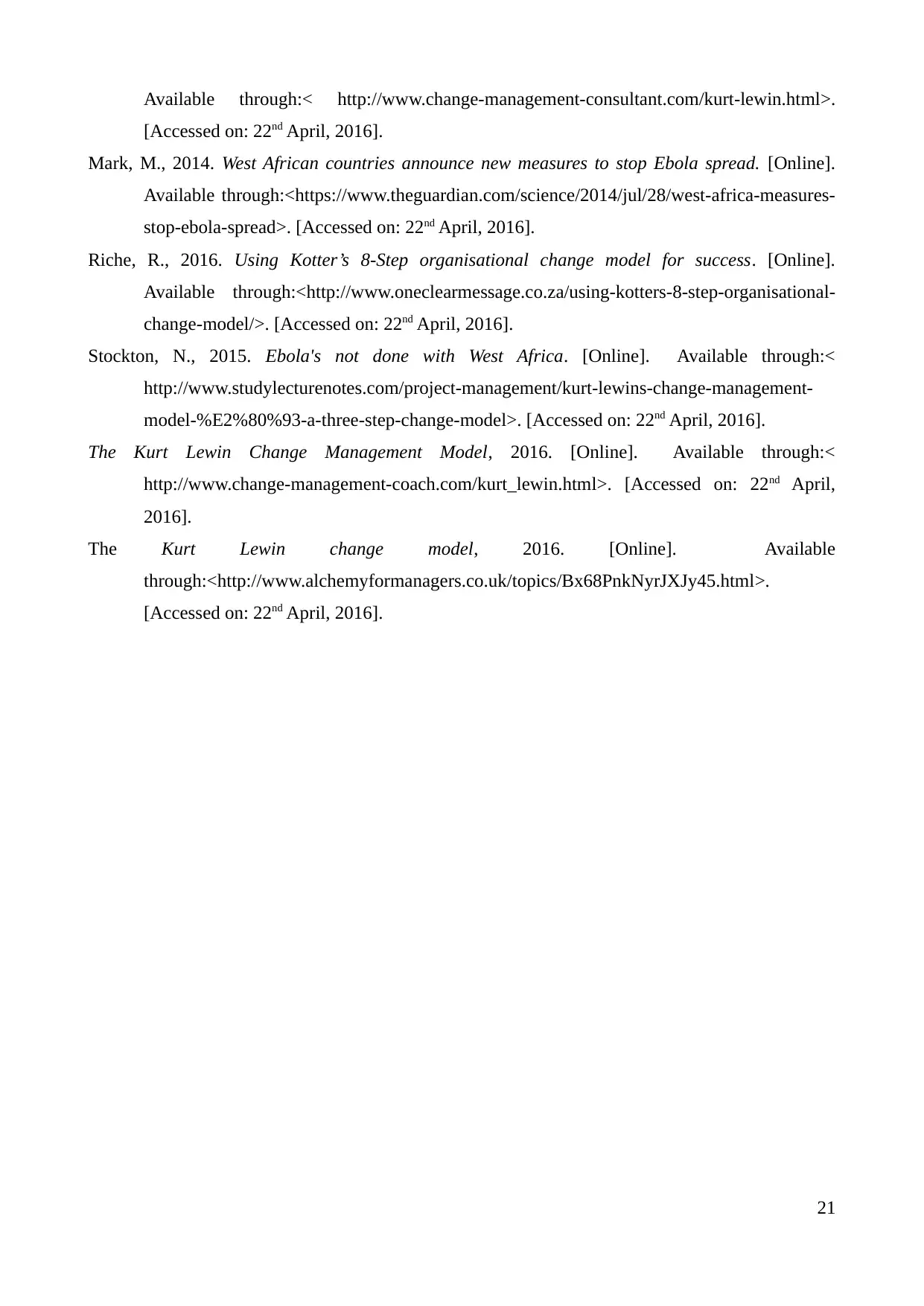
Available through:< http://www.change-management-consultant.com/kurt-lewin.html>.
[Accessed on: 22nd April, 2016].
Mark, M., 2014. West African countries announce new measures to stop Ebola spread. [Online].
Available through:<https://www.theguardian.com/science/2014/jul/28/west-africa-measures-
stop-ebola-spread>. [Accessed on: 22nd April, 2016].
Riche, R., 2016. Using Kotter’s 8-Step organisational change model for success. [Online].
Available through:<http://www.oneclearmessage.co.za/using-kotters-8-step-organisational-
change-model/>. [Accessed on: 22nd April, 2016].
Stockton, N., 2015. Ebola's not done with West Africa. [Online]. Available through:<
http://www.studylecturenotes.com/project-management/kurt-lewins-change-management-
model-%E2%80%93-a-three-step-change-model>. [Accessed on: 22nd April, 2016].
The Kurt Lewin Change Management Model, 2016. [Online]. Available through:<
http://www.change-management-coach.com/kurt_lewin.html>. [Accessed on: 22nd April,
2016].
The Kurt Lewin change model, 2016. [Online]. Available
through:<http://www.alchemyformanagers.co.uk/topics/Bx68PnkNyrJXJy45.html>.
[Accessed on: 22nd April, 2016].
21
[Accessed on: 22nd April, 2016].
Mark, M., 2014. West African countries announce new measures to stop Ebola spread. [Online].
Available through:<https://www.theguardian.com/science/2014/jul/28/west-africa-measures-
stop-ebola-spread>. [Accessed on: 22nd April, 2016].
Riche, R., 2016. Using Kotter’s 8-Step organisational change model for success. [Online].
Available through:<http://www.oneclearmessage.co.za/using-kotters-8-step-organisational-
change-model/>. [Accessed on: 22nd April, 2016].
Stockton, N., 2015. Ebola's not done with West Africa. [Online]. Available through:<
http://www.studylecturenotes.com/project-management/kurt-lewins-change-management-
model-%E2%80%93-a-three-step-change-model>. [Accessed on: 22nd April, 2016].
The Kurt Lewin Change Management Model, 2016. [Online]. Available through:<
http://www.change-management-coach.com/kurt_lewin.html>. [Accessed on: 22nd April,
2016].
The Kurt Lewin change model, 2016. [Online]. Available
through:<http://www.alchemyformanagers.co.uk/topics/Bx68PnkNyrJXJy45.html>.
[Accessed on: 22nd April, 2016].
21

22
1 out of 22
Related Documents
Your All-in-One AI-Powered Toolkit for Academic Success.
+13062052269
info@desklib.com
Available 24*7 on WhatsApp / Email
![[object Object]](/_next/static/media/star-bottom.7253800d.svg)
Unlock your academic potential
© 2024 | Zucol Services PVT LTD | All rights reserved.





